THE LINK to #urbanana:
the glory of the planned town – Brasília’s twin city
Buchwelten / in English: 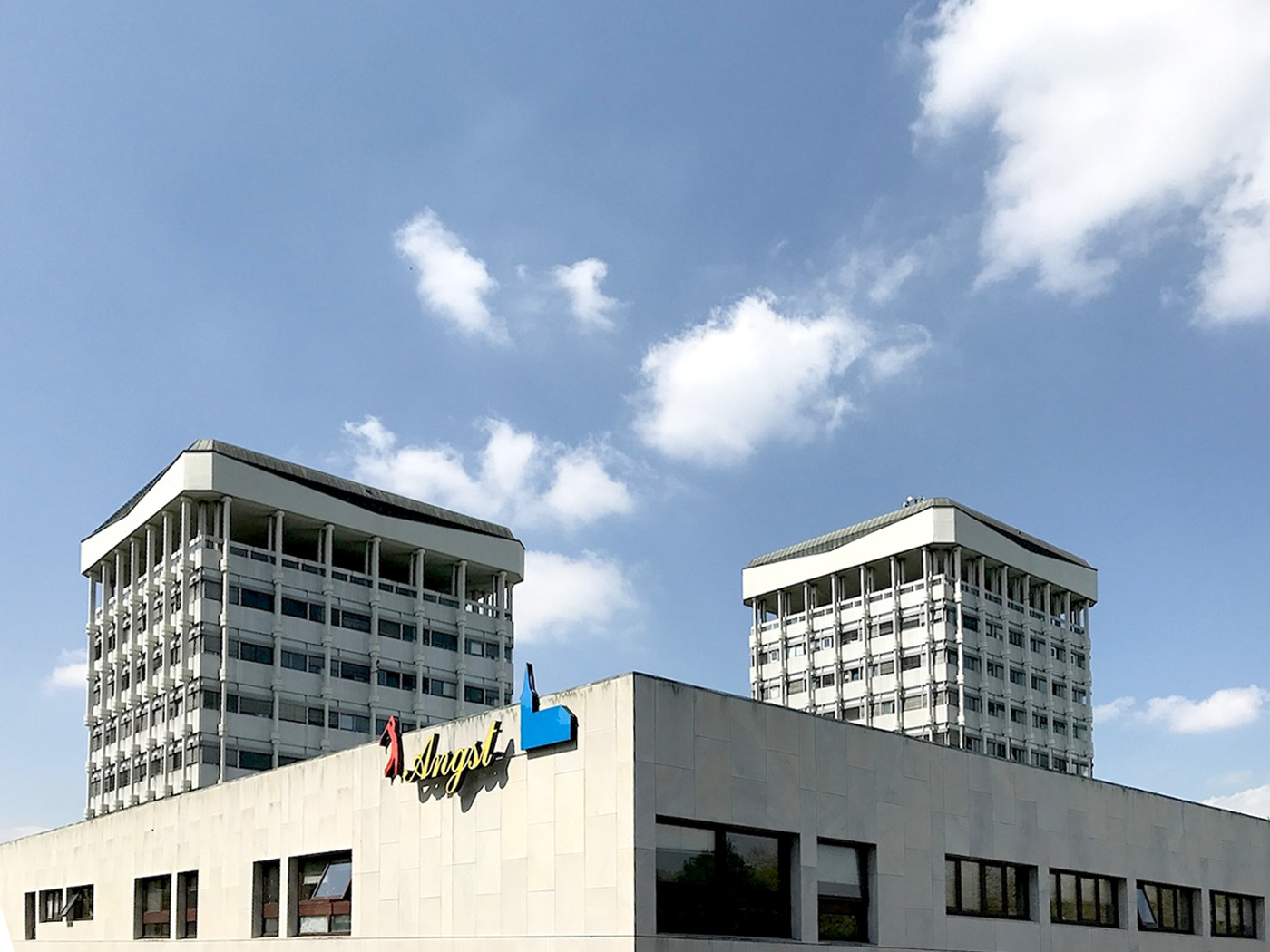
The German version: here.
There are towns that are appealing and pleasing at first glance. Because they are quaintly situated on a river. Because they have a picturesque old town. Maybe they even combine both. Marl isn’t such a town in the least, neither pleasing nor eager to please. Marl stood for courage, for creative drive, and was like the little relative of another planned city that started as an urban idea and became the capital of Brazil: Brasilia. The coal and chemical town was not chosen as a capital. But similar to the South American planned city, Marl became a symbol for the new man, the new architecture, the new urban visions of the 20th century. Marl, located on the northern end of the Ruhr Valley, was formed as a merger of small villages and settlements of miners and chemical workers working there. Population forecasts prophesied Marl would develop into a big city so that, starting in the 1960s, a modern town centre was planned and built with the town hall, residential multi-storey buildings, and a shopping centre. The ground-breaking was cast in concrete. Soon (in 1975), more than 90,000 people lived here, twice as many as shortly after the Second World War (40,000 inhabitants). Two thriving coal mines and a large chemical factory fostered the creation of the “Brasília of the FRG”: Marl had the most modern adult education centre in the country, Scharoun built his famous organic school, the town hall looked like a space station, and the city had the Grimme Award. Then came the closures of the coal mines and the structural transformation.
Today, Marl has visibly aged, is noticeably worn, clearly marked, and yet: This generosity. This area. This vast sky. This art. Standing on the Creiler Platz, the Creil Square, you can enjoy all that for yourself on this summer day. Even with many people and cyclists hurrying across the square, walking, driving - in its spaciousness, it remains like a broad urban free space. Or like an urban-airy plain. For this town with this kind of centre, there are at least two, and always two, interpretations: Here we are in the heart of a concrete monster of the Late Modern Era, beating irregularly. Or: We can experience a time journey into the visionary urban dreams of the 1960s, the likes of which exist only a few in this concentrated form. Because architecture, urban planning, and the design of space are always mirror images of their time, their boldness or timidity, their strength and weakness.
Time Journey into the Visionary Architecture of the Boom Town
I choose to travel to post-war modernity and to the economic wonderland. At that time, the clear lines of classical modernity made room for new ideas. Then, as before in the 1930s, it was again Le Corbusier who expanded and drove ahead the design possibilities of architecture. Marl looks like a reflection of this progress, of new urban planning ideas and socio-political developments. After the merger of several municipalities, the new town grew rapidly. Planners chose a loosely built car town, following Le Corbusier’s separation of work and life with plenty of green spaces. On the outskirts: coal mines, chemical industry, and industry. At the centre: Air, real castles in the air, and plenty of green spaces. The centre of the city is surrounded by the state road, L798, and the Herzlia-Allee, intersected and supported by the Hervester Straße and Bergstraße, which creating a sweeping curve right into the heart of the town: the town hall. Which brings us to one of the protagonists of the birth of Marl: the mayor, Rudolf Heiland, member of the SPD, antifascist and member of the resistance in the Third Reich. The independent merchant was Mayor of Marl from 1946 until his death in 1965. As an economic miracle worker, he put his mark on the merger of Marl’s districts and, above all, the construction projects. The revenues from local business taxes, especially from the chemical works in the Hüls district, gave him the opportunity to plan and commission extravagantly and ambitiously: The town hall was designed by the architects van den Broek and Bakema, (completed in 1967); the mountain dwellings and the school created by Hans Scharoun (completed in 1970).
As I walk around the town hall, I think of Eugène Claudius-Petit, the Mayor of Firminy. In the French small town in the Auvergne-Rhône-Alpes region, he was also a decisively-active town leader, who was inspired by, and implemented, visions of urban planning. In his case, he worked with Le Corbusier, who designed Firminy-Vert in the 1960s, the only urban planning project of the super architect that was implemented in Europe and today’s pilgrimage for architecture enthusiasts. While Firminy’s concrete attractions are compactly grouped around the fantastic church, Église Saint-Pierre, the modernity of Marl is spread over the entire town area.
»Marl builds the thoughts of an open society, a society in which everyone has the right to shape their lives in their own way and to testify to that through built shapes. Thus, the city crown of Marl will interpret as it will invite, dictate as it will ask, enclose as it will open up, serve, and stimulate, as well as invite the individual to co-operation and, through this co-operation, create better conditions for the individual, create personality.«
Jacob Berend Bakema, 1964, architect

Town hall of Marl
"One of the most exciting events in the field of urban planning of our time,” according to the judgement of the trade journal, Architektur und Wohnform."
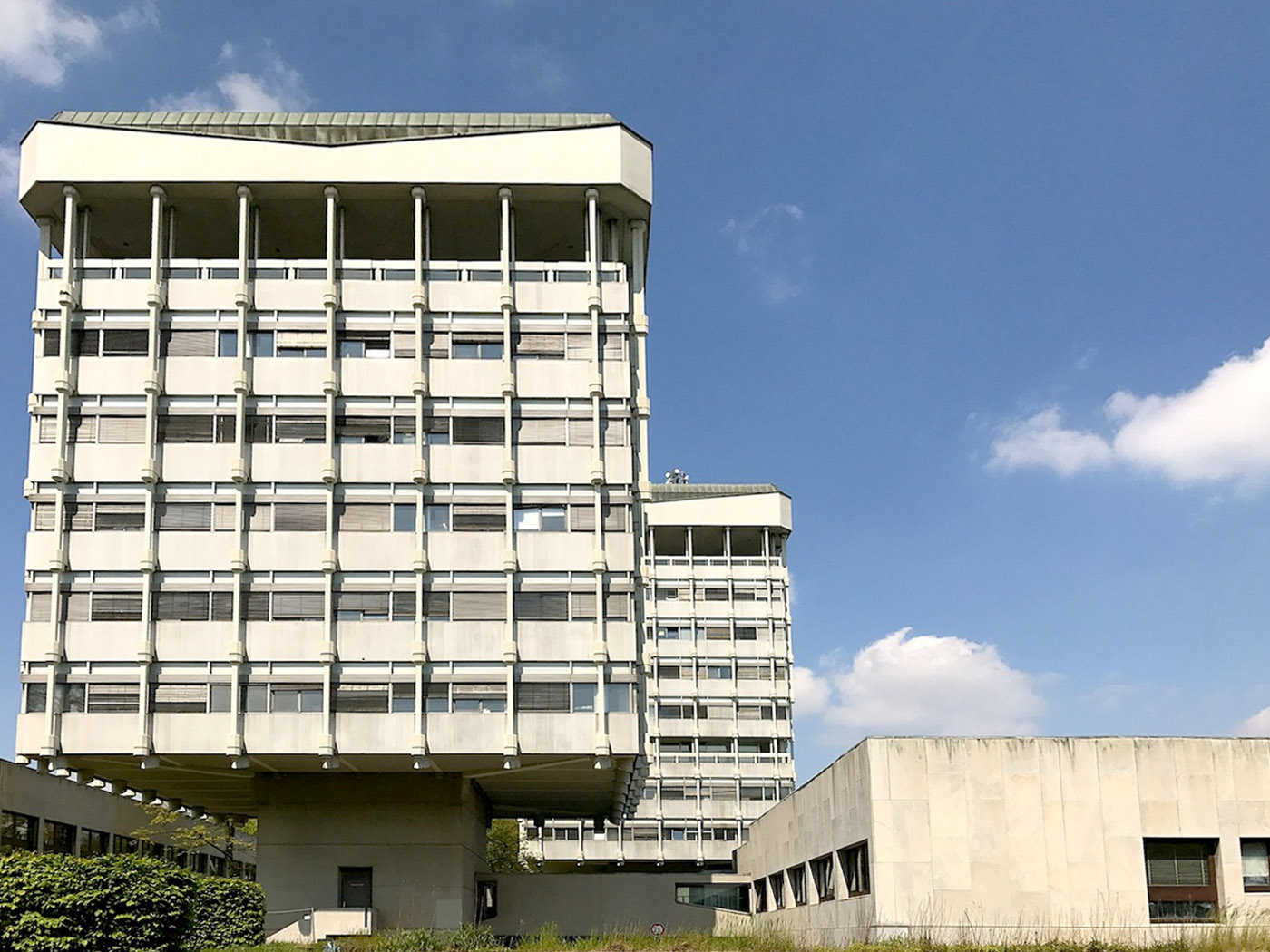
Town hall of Marl
Due to their suspension construction, the towers were an architectural novelty and were the first suspension high-rises of the Federal Republic of Germany.
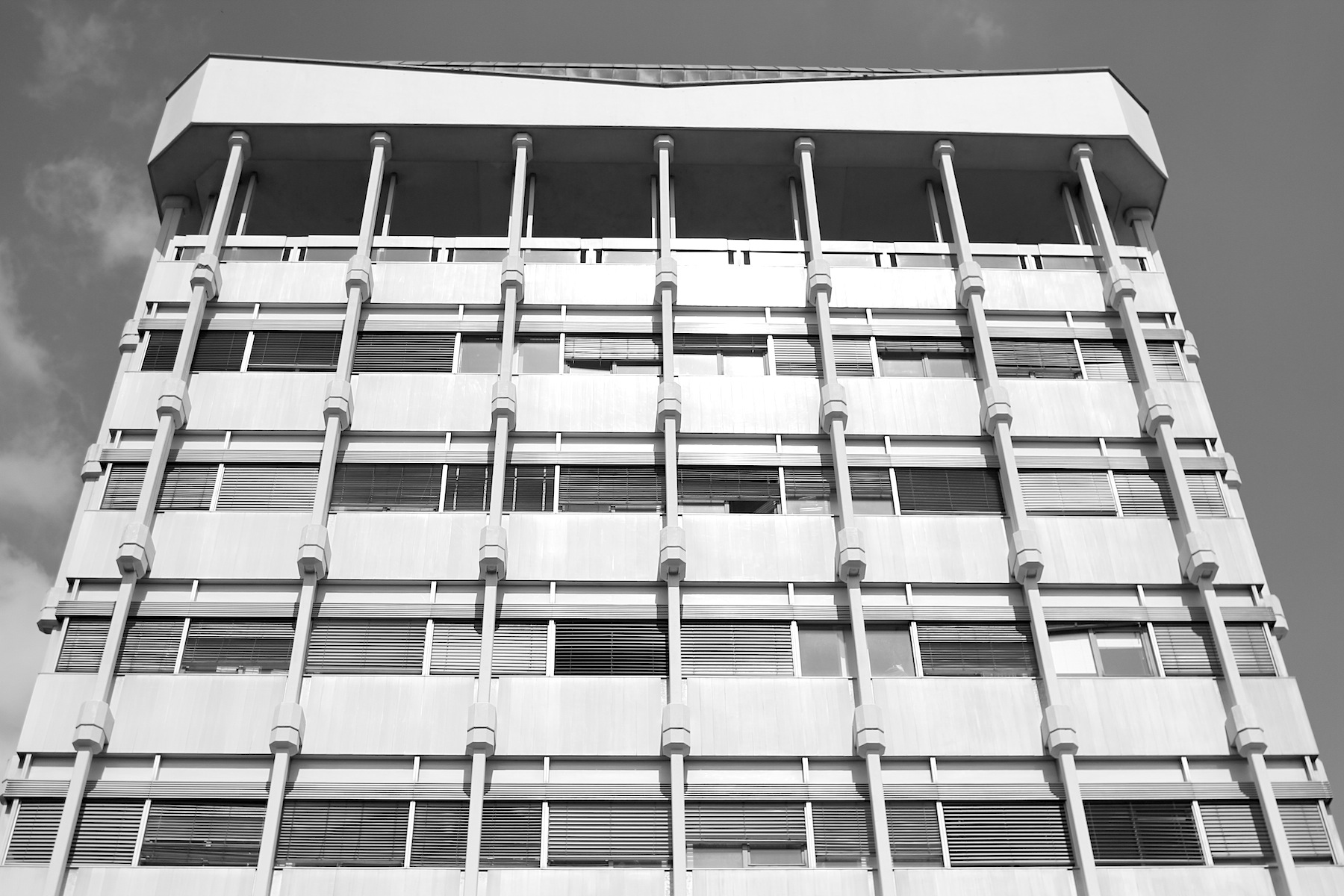
Town hall of Marl
The building complex is located at Creiler Platz No. 1 (Creil Square), named after the French twin city of Creil.
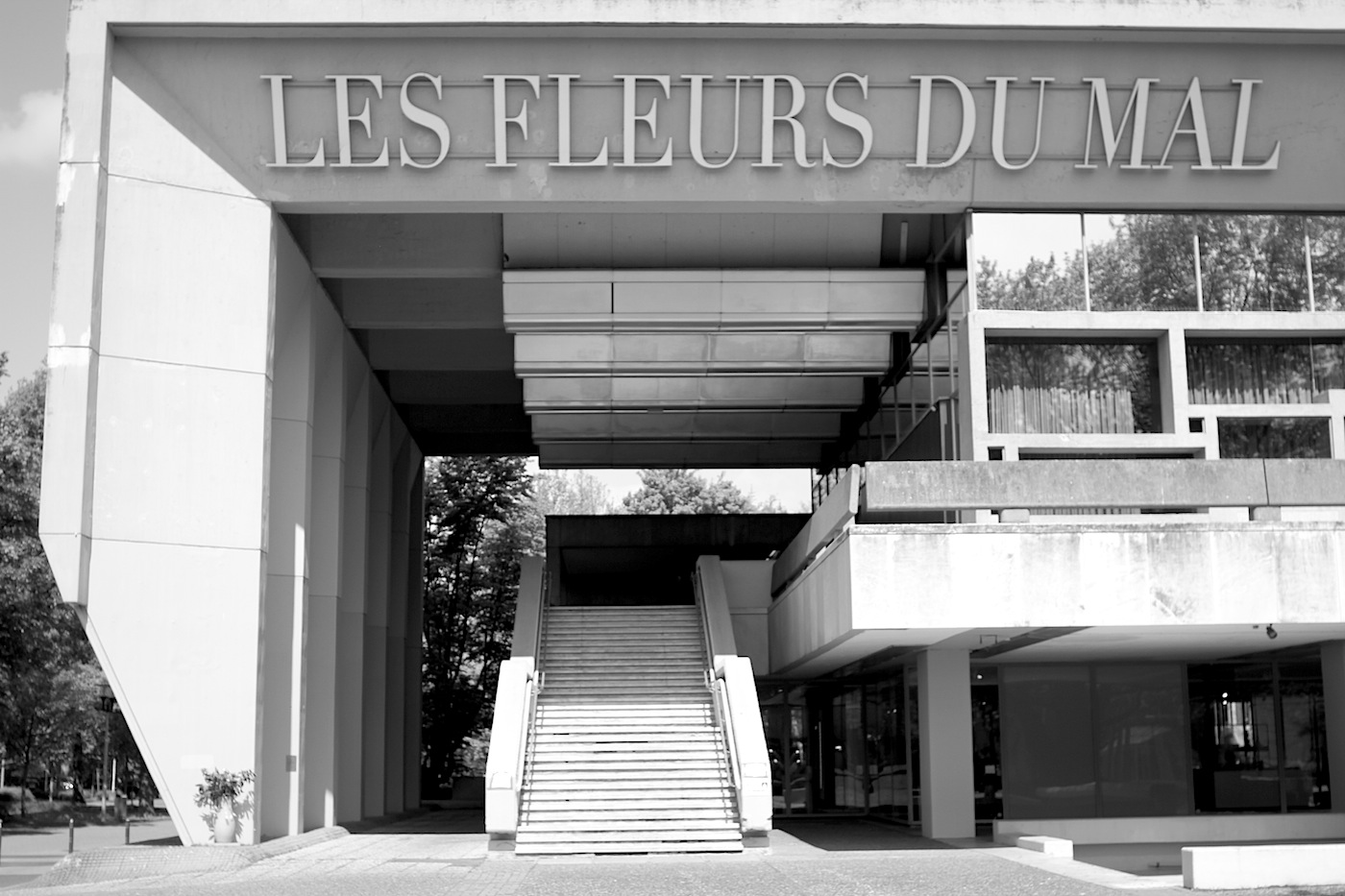
Les Fleurs Du Mal
"The Flowers of Evil" is written on the edge of the façade of the town hall, the museum of sculptures, opened in 1982, and the free staircase to the civil registry office – an installation by the light artist, Mischa Kuball, combining the title of the poem cycle by Baudelaire with the word play Flowers for Marl.
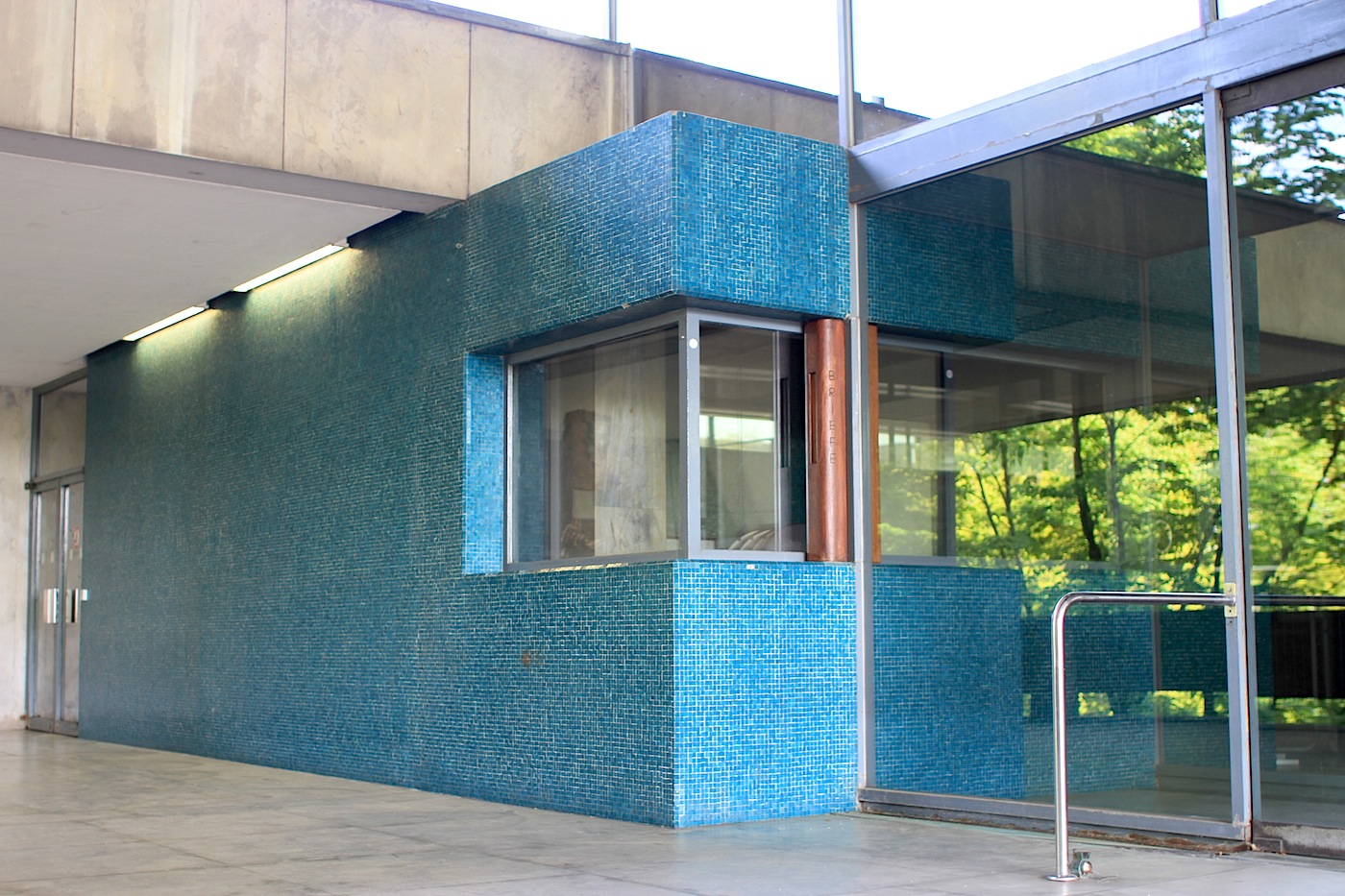
Town hall of Marl
Entrance register office
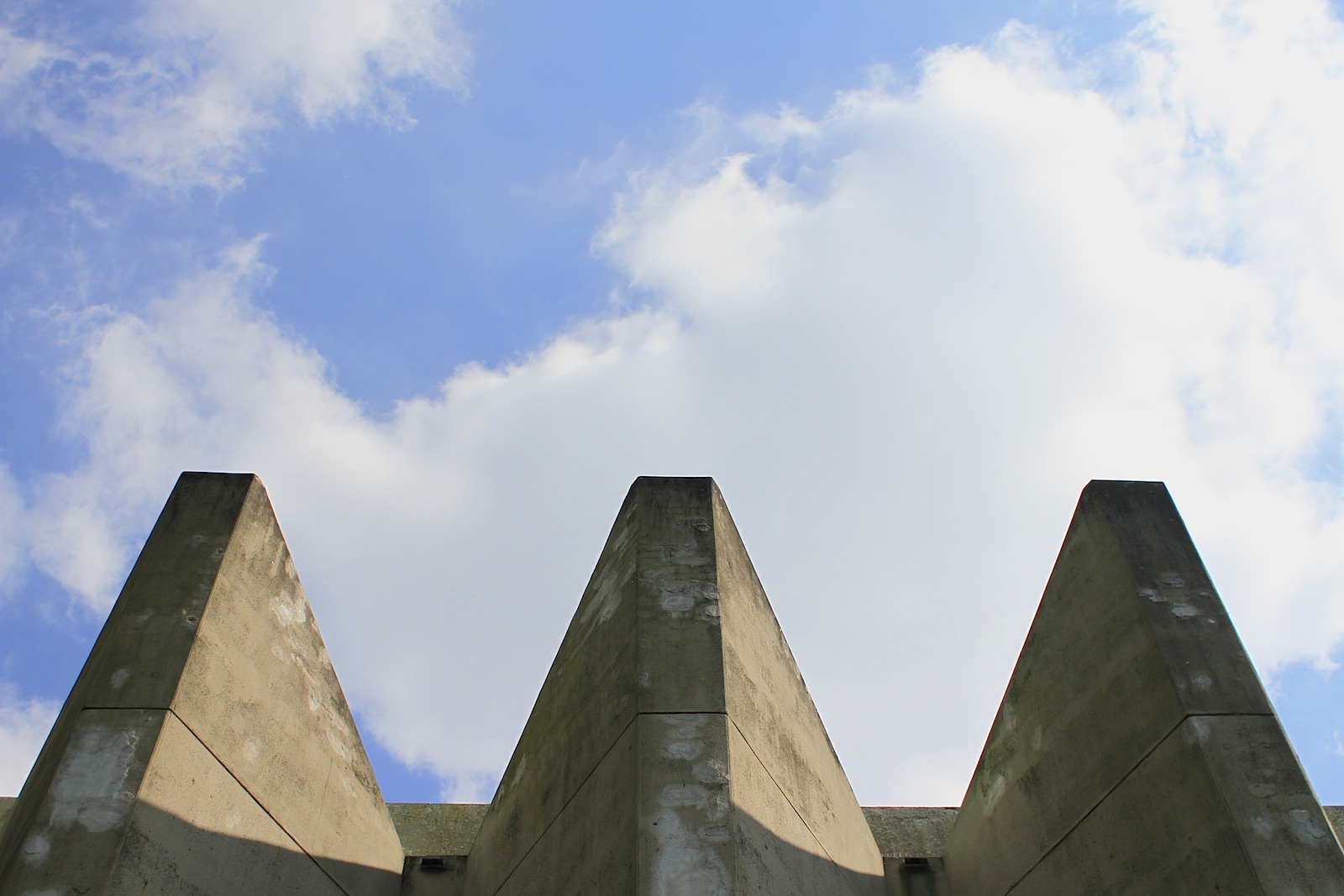
Town hall of Marl
The prestressed concrete folding roof of the meeting wing is 60 meters long and 28 meters wide.
»Today is a day of memorable, historical significance. As Mayor, I welcome the citizens of this town because they are the foundation and the purpose of today’s day ... I am of the opinion that the future of our buildings we are building today ... a town hall such as this, is built for centuries.«
Rudolf Heiland, Mayor of Marl, 1954
“And at the conclusion, I will be a cheeky fellow again: please, please, let’s build three towers if we can; three towers can create a space, two only create a line,” architect Bakema asked the decision makers for the construction of the town hall. The originally proposed four towers didn’t materialise; the line was built with two departmental towers. Nevertheless, the result was what the builder, the Town of Marl, had demanded: fluid, open, and functional. The complex consists of the council wing, the public building, and the two towers with heights of 34.60 meters and 42.60 metres, respectively. The shape of these reinforced concrete buildings with suspended aluminium façades is a result of the construction with a slender base, projecting storeys, and the roof, which is offset by open storeys. The towers were built as suspended high-rises, the first of their kind in the FRG. In this technique, a concrete core with stairways and lift shafts is built up from the foundation. Each storey is then suspended one-by-one from top to bottom. Unfortunately, the suspension members were not sturdy enough. Weather and environmental impacts required restoration of the towers, which were regarded as a bold construction by critics. Added to this were obsolete technology, enhancement of the structural engineering calculation, and the lack of thermal insulation. Demolition or restoration? A debate similar to the discussion about the Scharoun school.
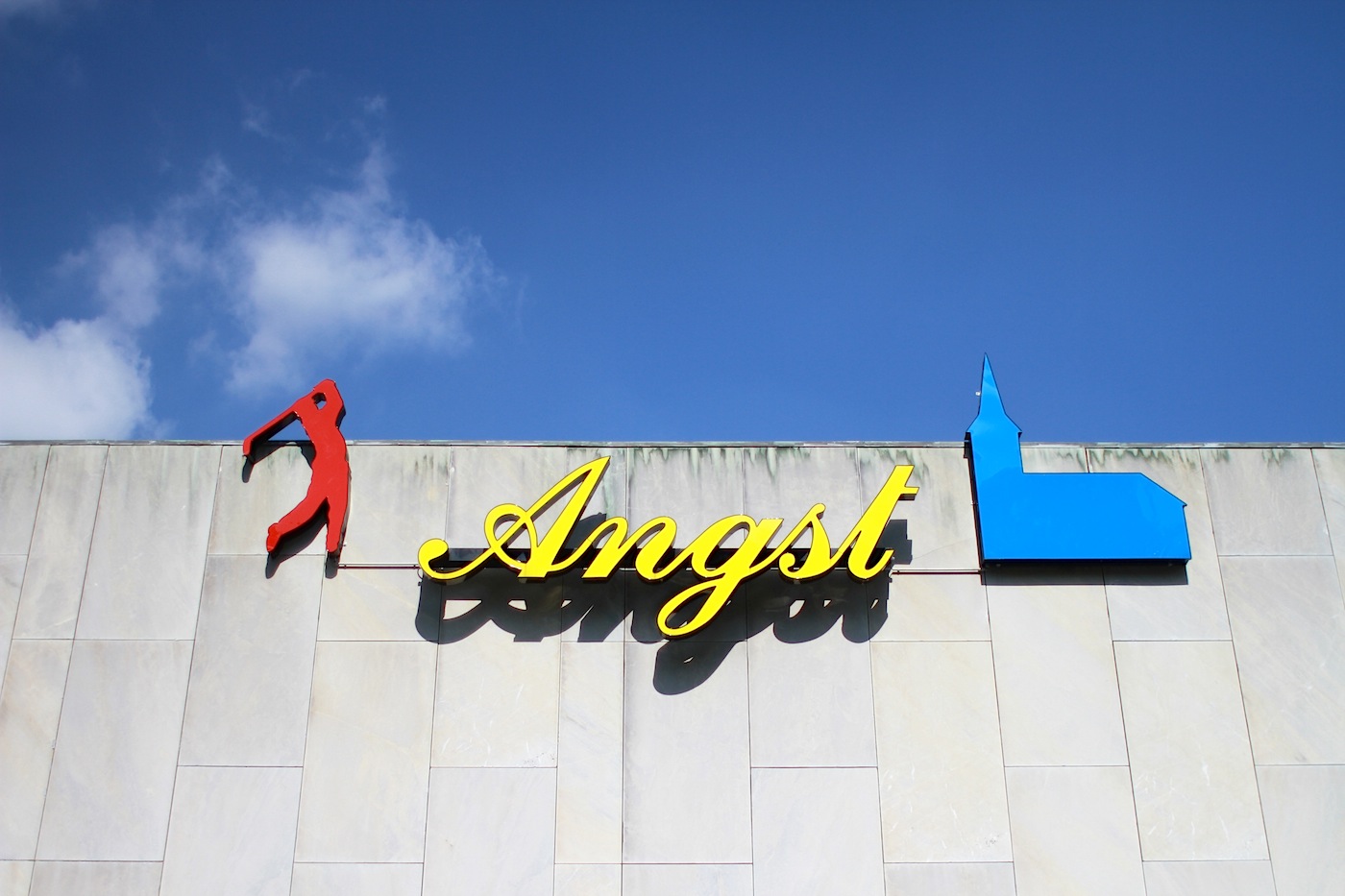
Neon-Piece (Fear)
Striking and impressive: the unusual density of first-class, national and international works of art in the centre of Marl. Some of the works were acquired before the construction of the town hall and the opening of the sculpture museum in 1982. The photo shows a work by the German painter, sculptor, and multimedia artist, Ludger Gerdes (1954–2008).
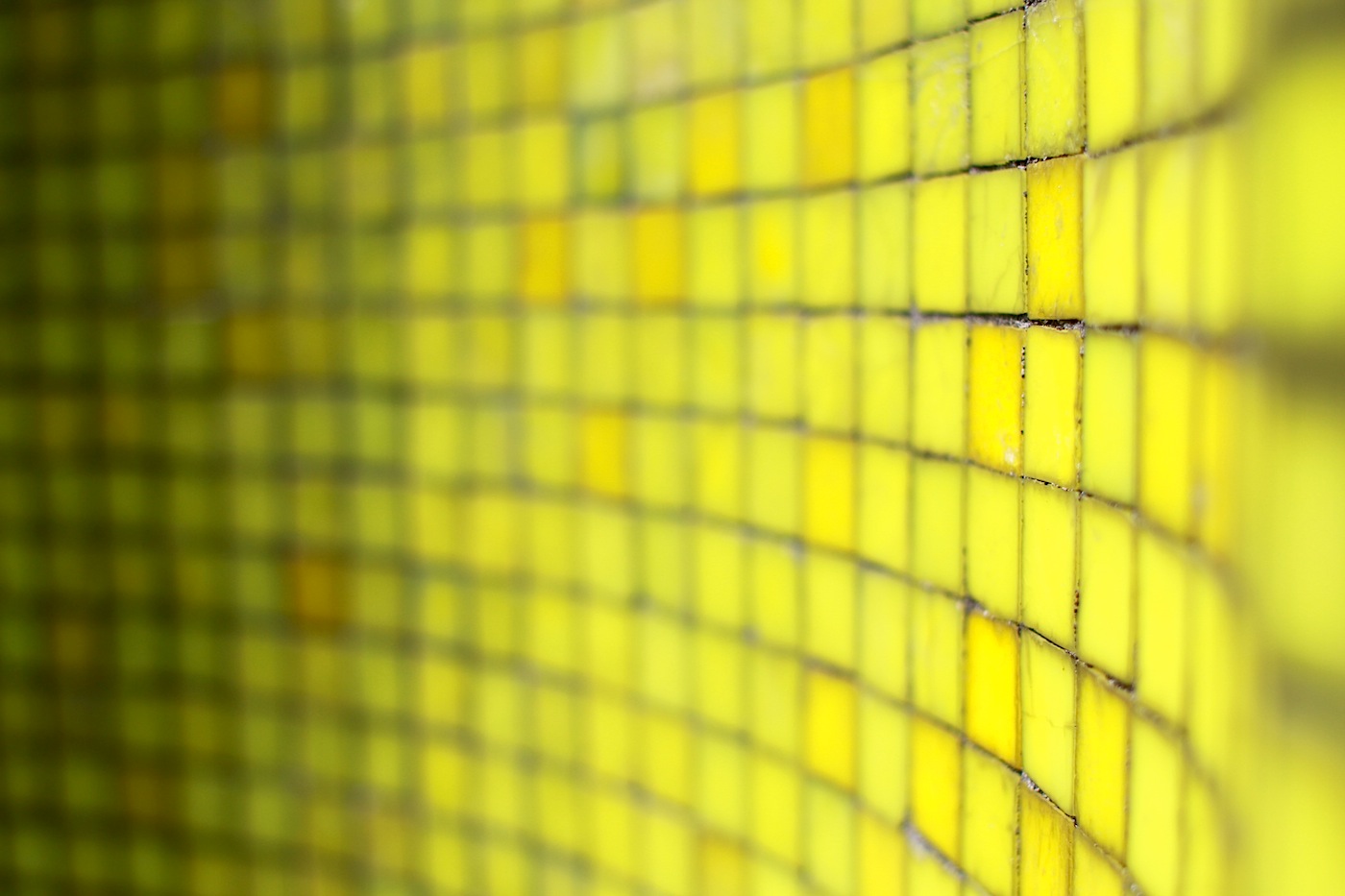
Town hall of Marl
Forecourt and Creil Square
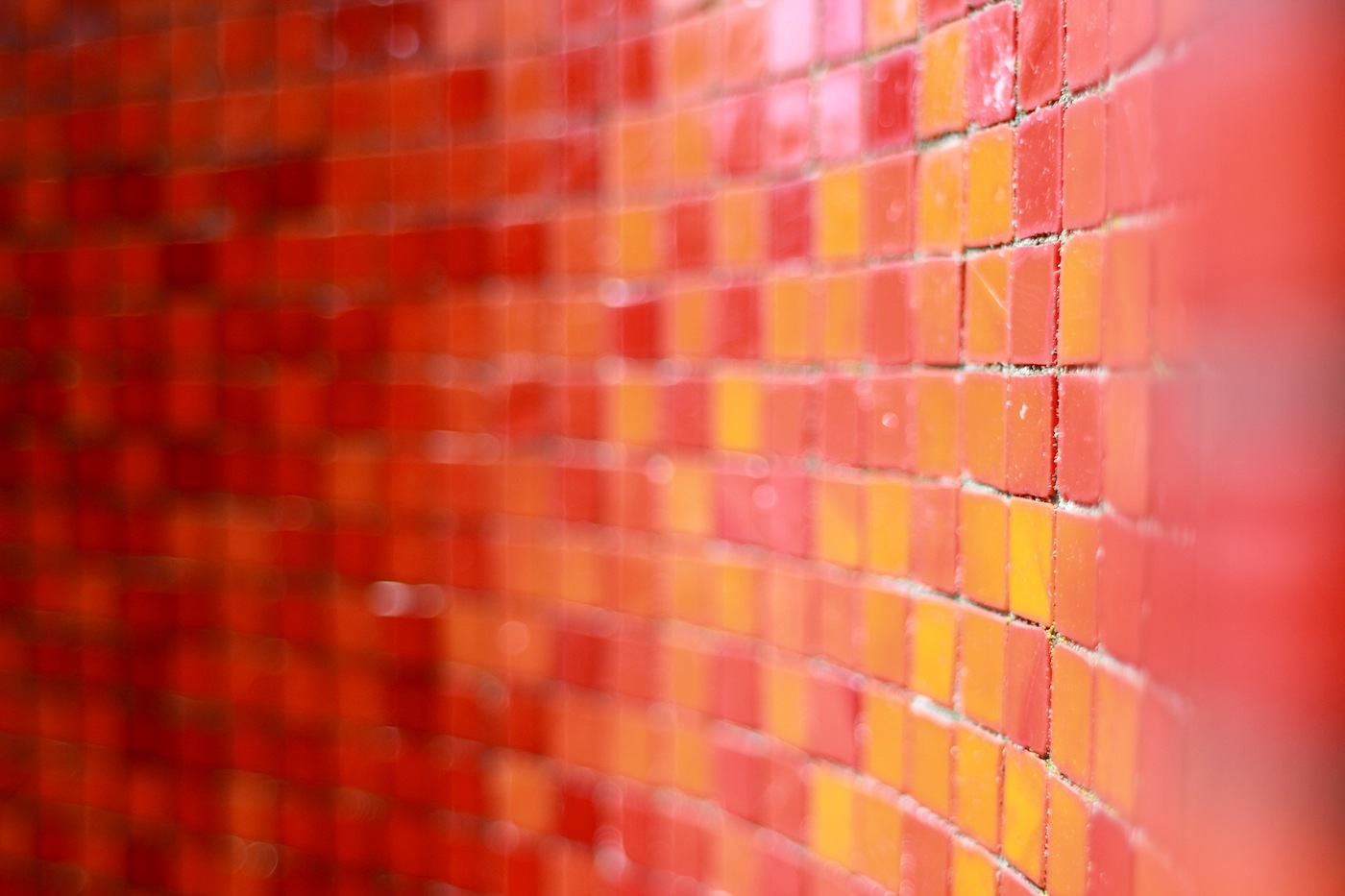
Town hall of Marl
Forecourt and Creil Square
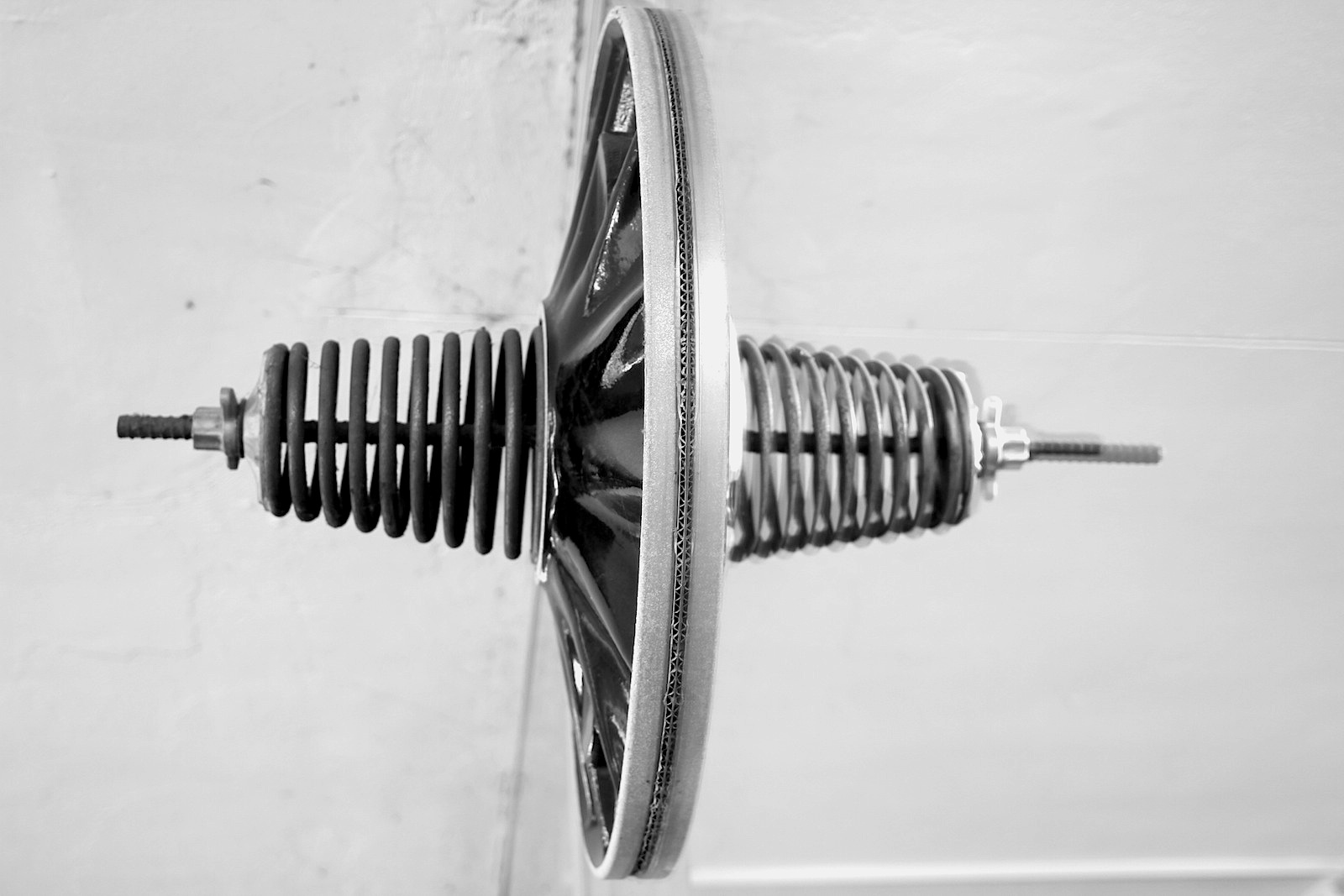
Skulpturenmuseum Glaskasten
Gloriole, 1996 by Eberhard Bosslet
Our interview with the artist Eberhard Bosslet (in German language): here.

Town hall of Marl
“7-1973” by William Brauhauser
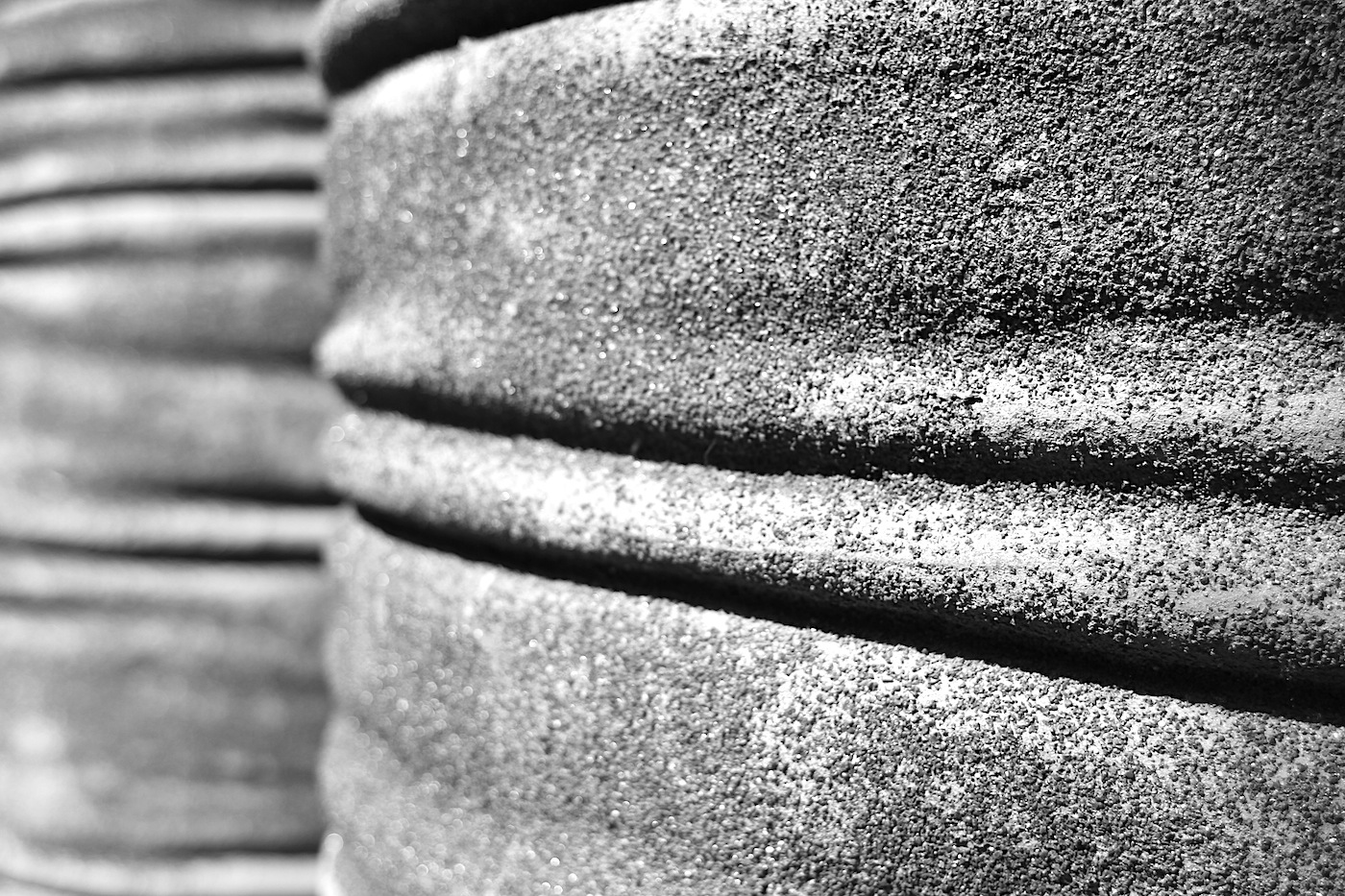
Skulpturenmuseum Glaskasten
Baalbek Gate, 1977, by Carl Bucher
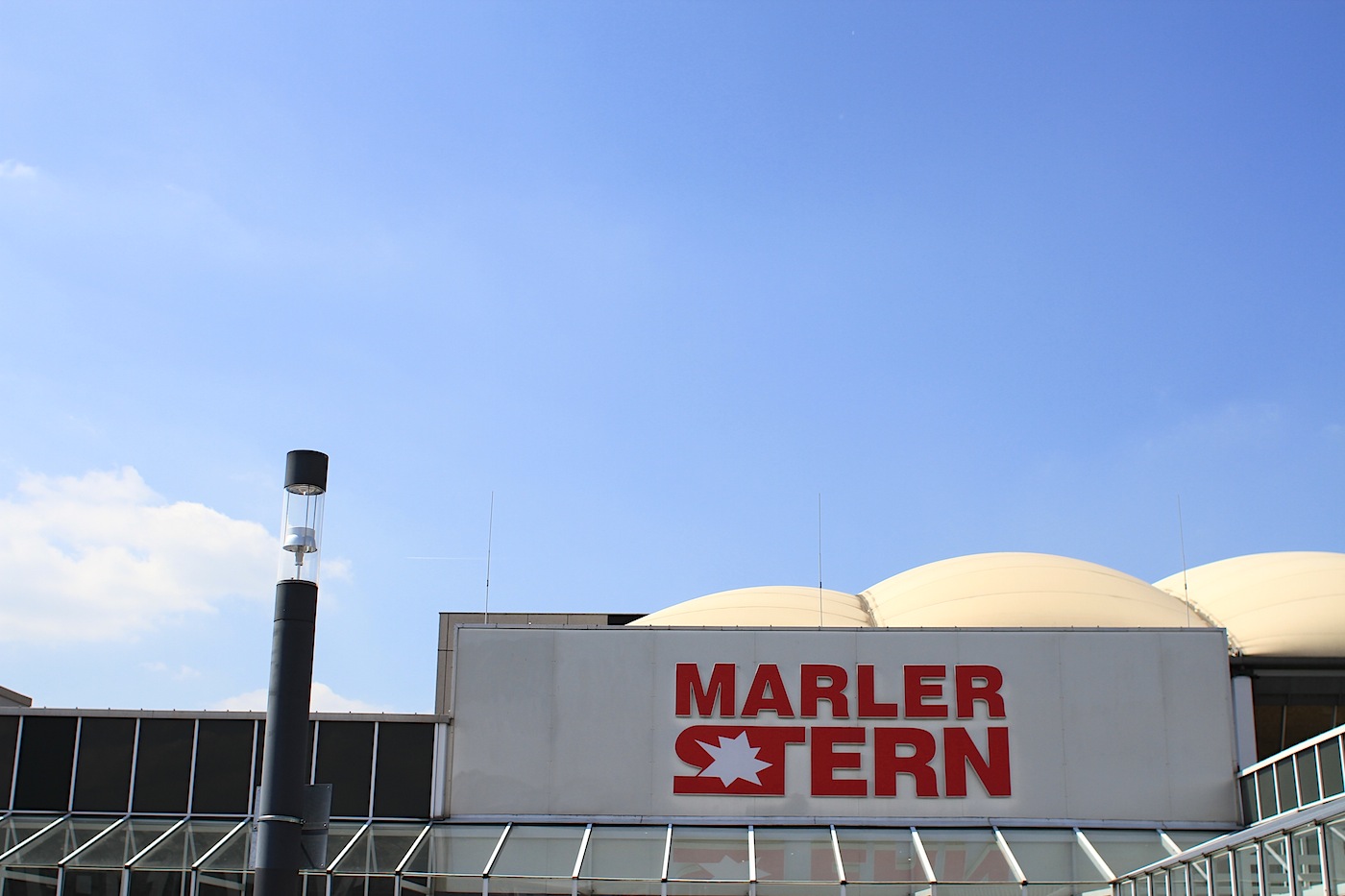
Marler Stern
Mayor Dr. Ernst Immel and Dr. Carl Schätzle, Managing Director of City-Bau KG, laid the foundation stone for the construction of the city centre on 25th of April, 1972.
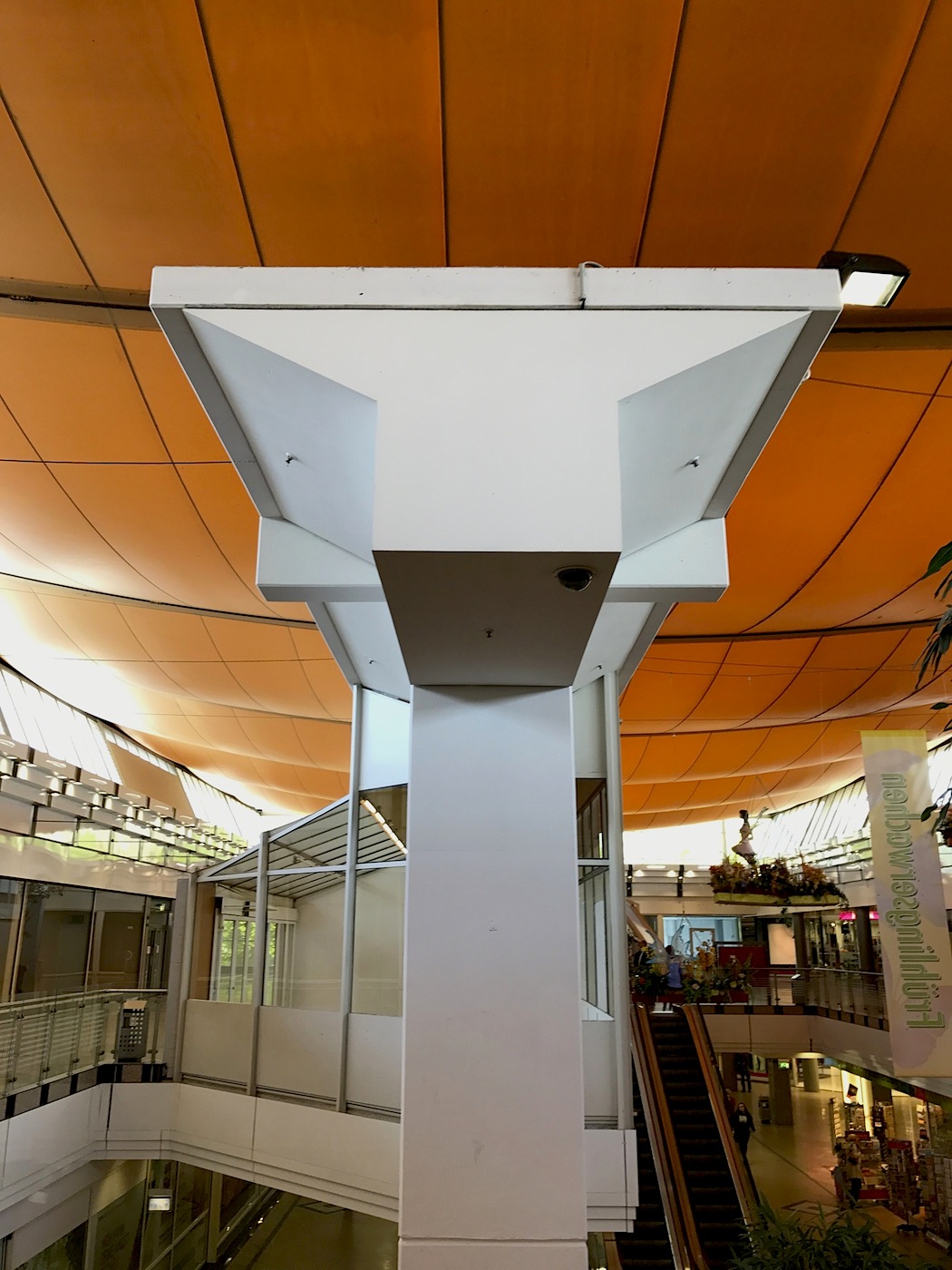
Marler Stern
In the following years, the Marler Stern shopping mall with Europe’s largest air cushion roof, the Karstadt department store, the buildings of the insel-VHS, the Riegelhaus, the car park, and the central bus station above Bergstrasse were constructed.
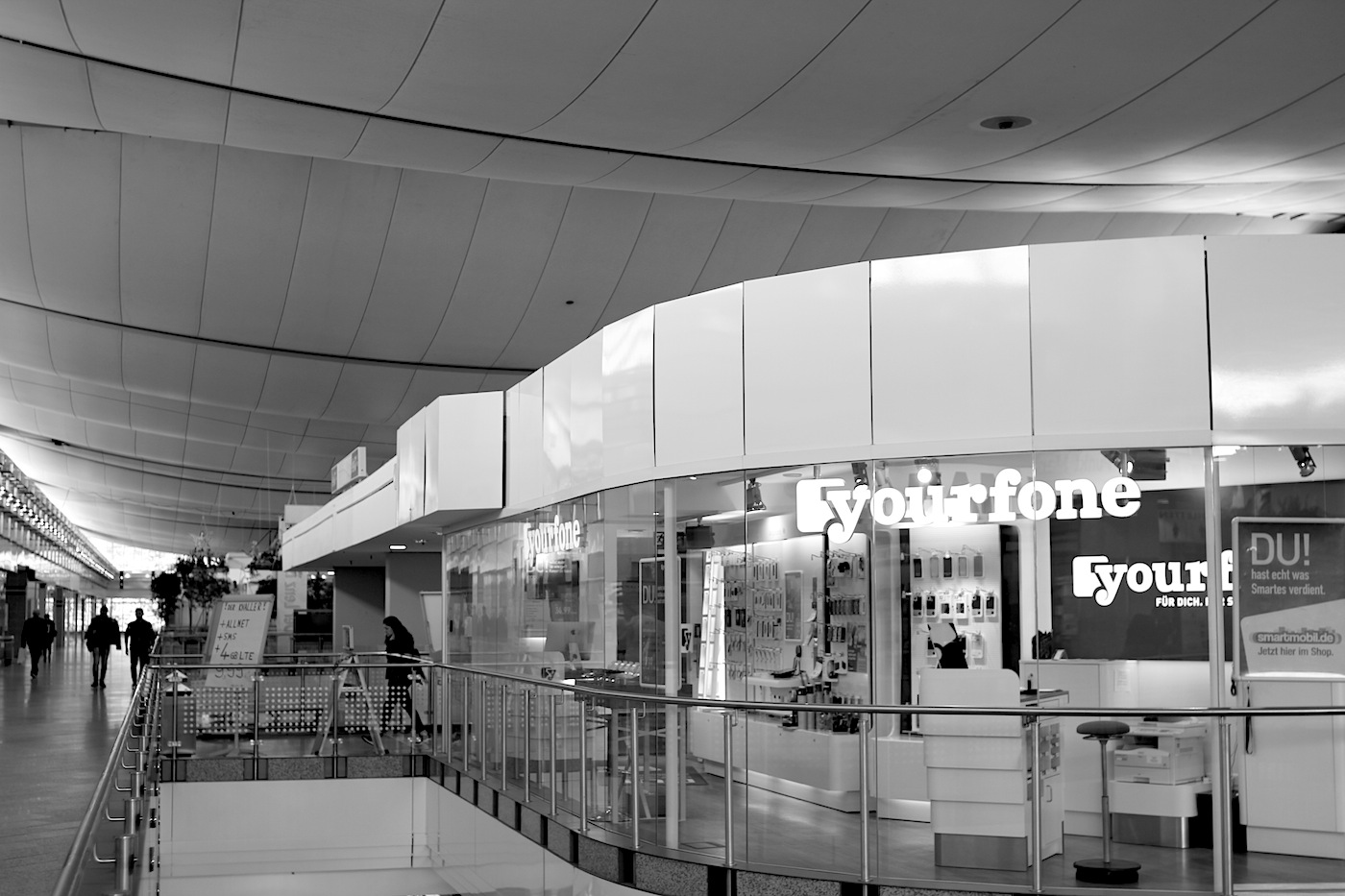
Marler Stern
The roof is listed in the Guinness World Records.
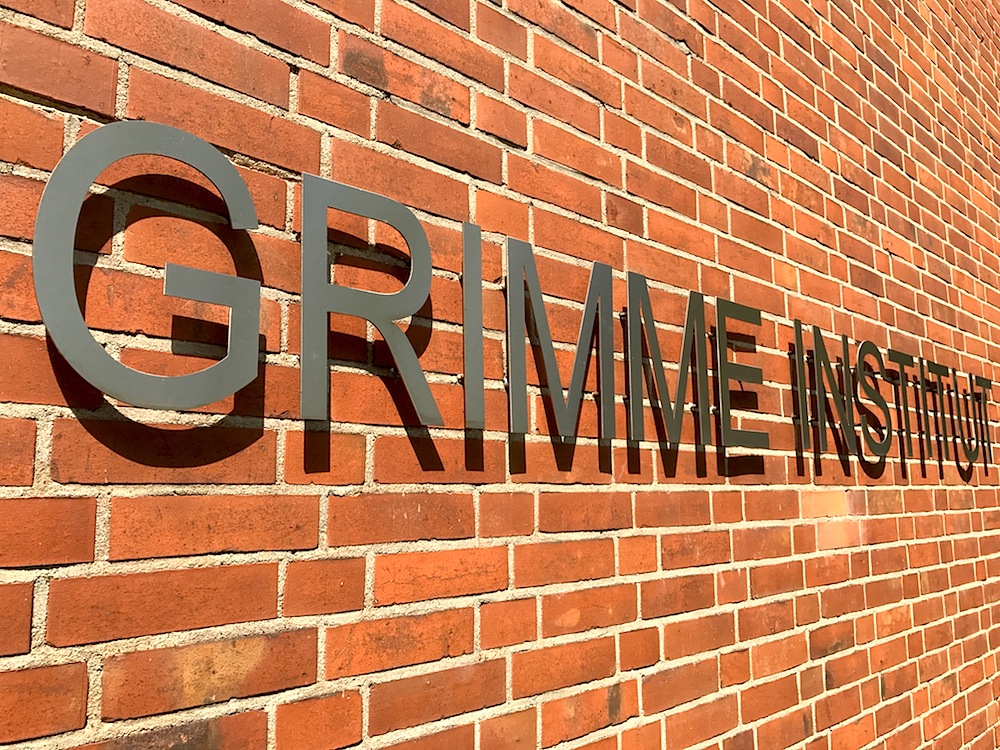
Grimme Institute
An example of post-war modernity of the 1950s, designed by Günter Marschall and ...
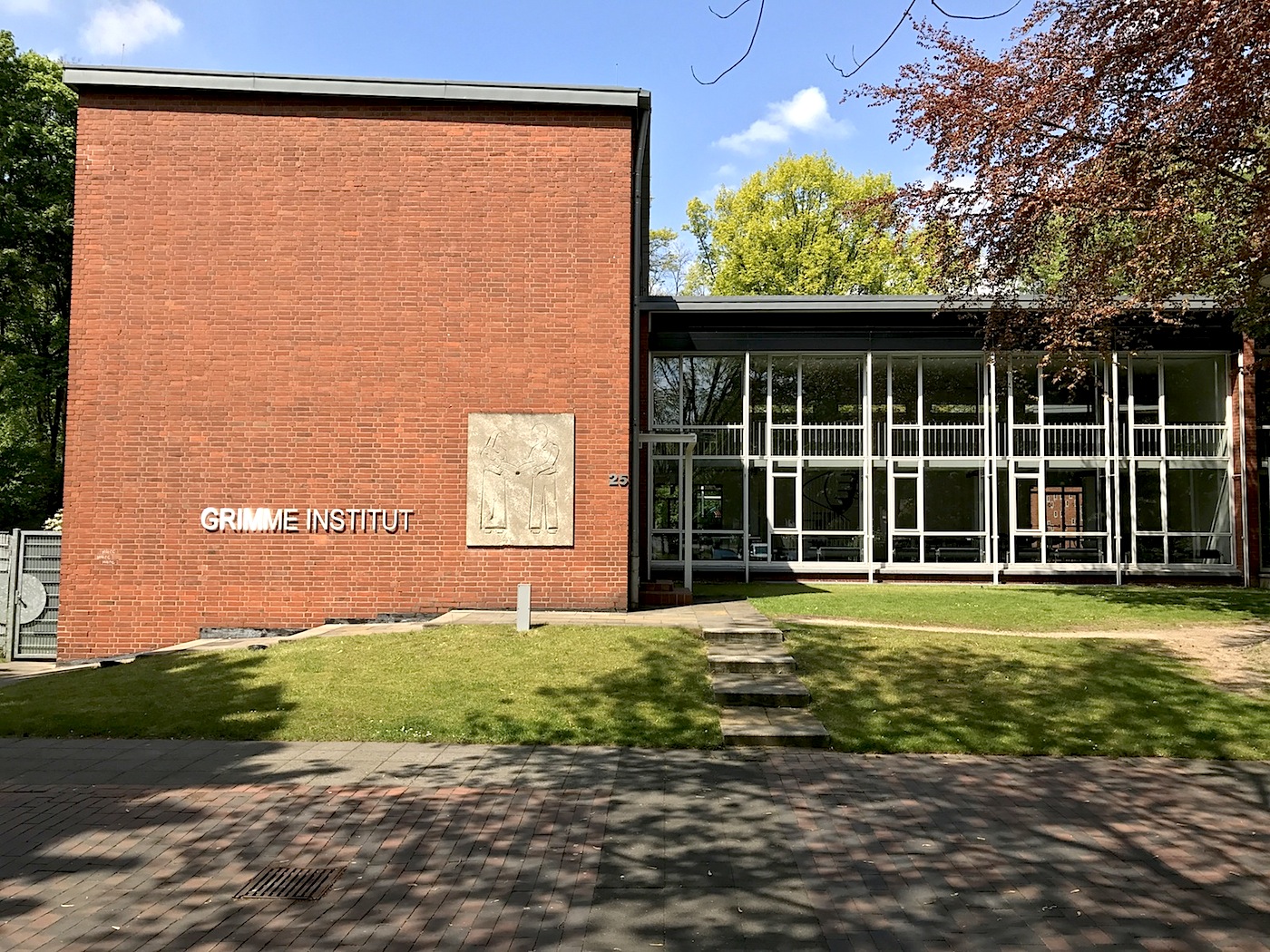
Grimme Institute
... at the same time the most modern adult education centre of the Federal Republic of Germany.
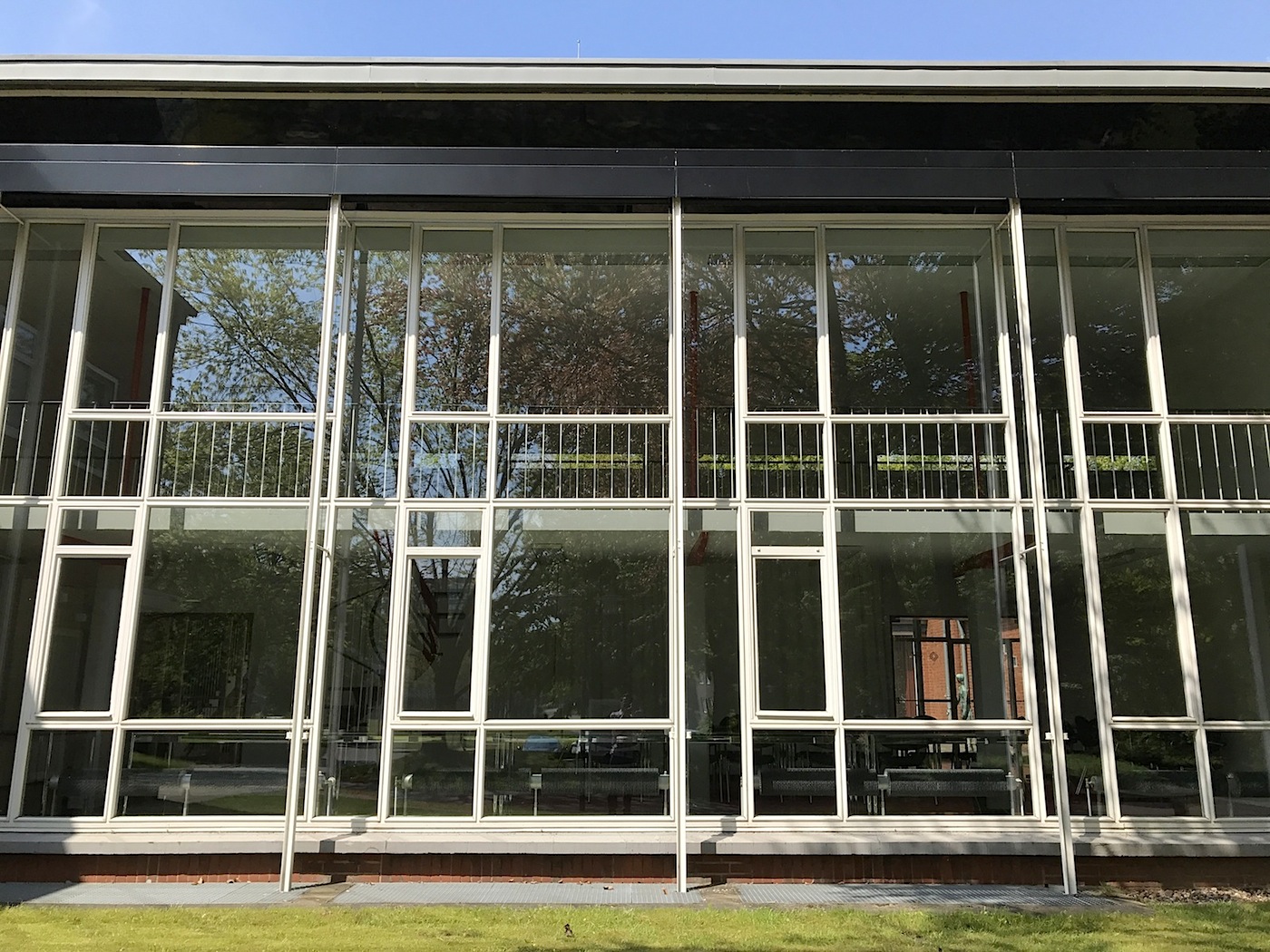
Grimme Institute
Transparency, levity, and the successful mixture of glass, steel, and brick characterise the construction, which was renovated in 2005.
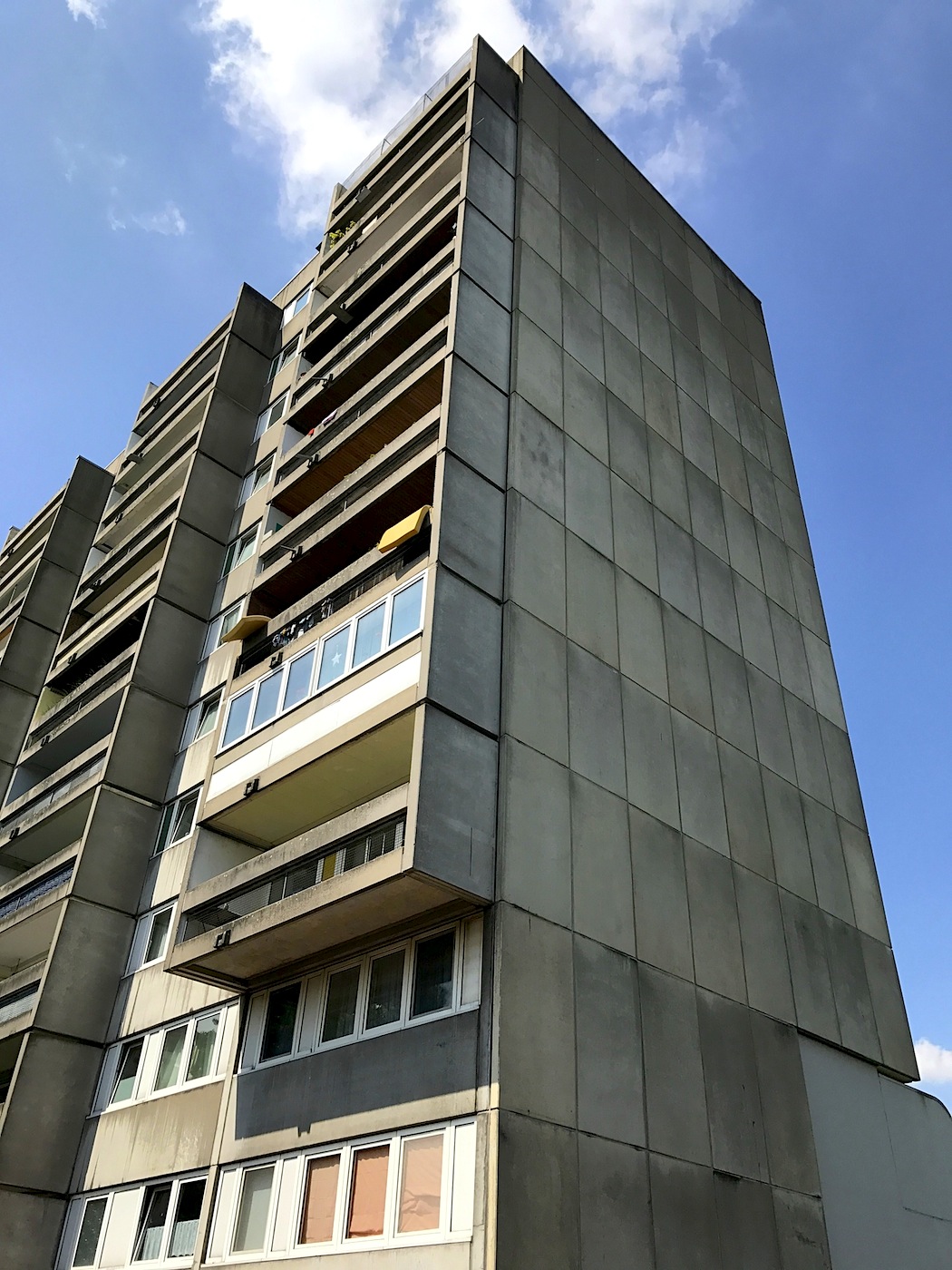
“Wohnen Ost” and “Wohnen West”
Best regards from …
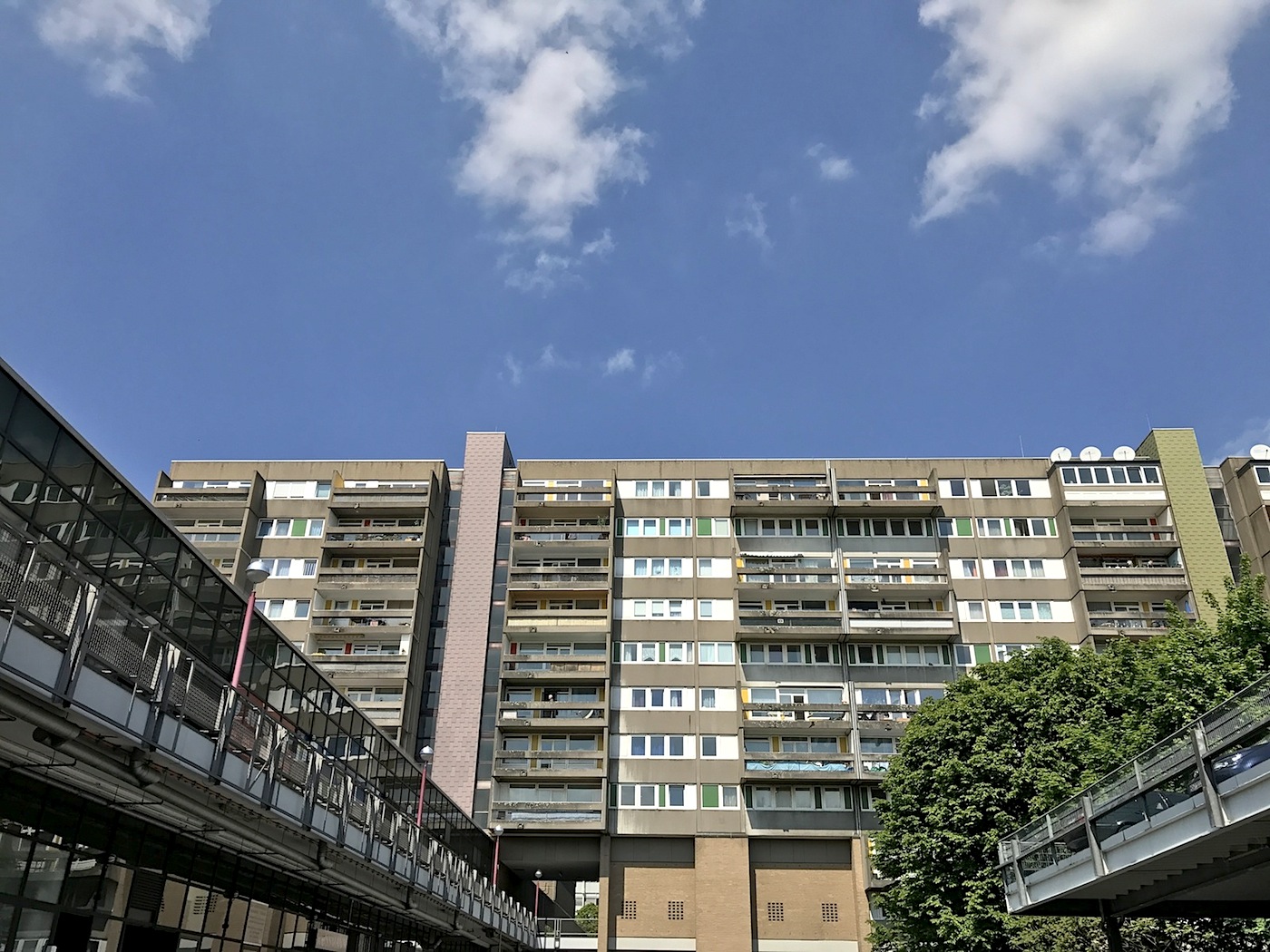
“Wohnen Ost” and “Wohnen West”
… Le Corbusier and his Unité d’Habitation”
»A school building should not be the symbol of political power or the result of technical or artistic perfection. Like any other building, a school should convey an idea of life that corresponds to the universal principle of democracy.«
Hans Scharoun, architect, 1961
Scharoun school and the mountain dwellings
The Scharoun school in Marl, designed in the style of organic architecture, with an auditorium for 522, a gymnasium, and classrooms, was completed in 1970. The organic becomes evident in a top view of the grounds: Five building wings extend from the centre like rays and are arranged asymmetrically; the individual classes are shaped like honeycombs and pavilions.
Organic architecture, that’s all well and good. But here, too, social and economic change was palpable. Demolition or retirement home? The answer: Architects, conservationists, and citizens joint together to preserve the school as well as restore it. In the summer of 2015, the building was completely renovated. The drive to the school through the district of Drewer is marked by the miners’ settlements: straight-lined, unpretentious flat-roofed buildings with plenty of green spaces. Like residential and natural islands, the large, multi-lane streets, so typical for Marl, are suddenly distant.
The south-west is similar. Coming from the heavily trafficked axes, Herzlia-Allee and Hochstraße and driving down Kreuzstraße, single-family homes soon dominate with idyllic front gardens and carports. Then the road makes a left curve and suddenly it looks almost monumental for local standards: Mountain dwellings piling up. Starting in 1965, this is where the first mountain dwellings in Europe were constructed, a combination of family homes, height, and densification. For the first time, a type of building was constructed in which the floor area decreases towards the top and the storeys are set back. The idea, developed by Stuttgart architects, Roland Frey, Hermann Schröder, and Klaus Schmidt, was taken and implemented by the construction company, Neue Marler Baugesellschaft (NEUMA). In 1966, a four-storey building was built as a bulk concrete building, featuring a triangular cross-section with four large flats on the ground floor. The set-back first storey above had also four, but smaller, flats, the second storey had two, and the third storey had only one.
After initial hesitation about the unusual shape, the people of Marl quickly accepted the mountain dwellings. By 1982, three more houses of this kind had been built in the immediate vicinity. In issue no. 31 of 1968, the German magazine, Spiegel, stated:
»It takes a magnifying glass, as it were, to make out a few examples of exemplary German residential construction, such as terraced houses as found in Marl, some buildings in West Berlin Hansaviertel, the Munich residential centre, Arabella Park, or the residential buildings, Max und Moritz, in Munich Solln.«
Spiegel magazine, 1968
What is noticeable when walking through these lovingly maintained residential pyramids is this: the affection for the houses. The terraces are lushly landscaped, the entrances are nicely kept, and the windows show everything from lace-curtains to pleats, everything except for neglect or unsightliness. Here, demolition is out of the question. On the contrary. The remarks of the architects responsible for the first mountain dwellings sound prophetic. In any case, they are as true half a century later as they were then:
»Today, housing construction must consider, in particular, the growing scarcity of building land and ever-increasing motorisation. However, we need to find types of housing that, despite the necessary densification of the residential areas, offer space for the life of a family and are versatile so they can pay justice to the diversity of our society.«
Roland Frey, Hermann Schröder, Klaus Schmidt, architects from Stuttgart, 1967
Diversity of our society? Necessary densification? The ideas for the old Modern Marl are. The new town may have gotten old. And some of the utopias may be a thing of the past fifty years later. But Marl is adapting as it has always done. Even during the fat years, when plenty of money gave birth to the visionary architecture. And when the city began to shrink, the people asked themselves the urgent question: demolish or preserve? Firstly, one has to budget, which is and will remain difficult in the face of the emergency budget situation. Nevertheless, the poor structural condition of the town hall needs to be corrected and the city centre will be upgraded with a comprehensive package of measures. The renovation of the town hall is expected to cost about 39 million Euros.
This town has at least two, and always two, interpretations: The old economic wonderland, and with it, the willingness to make a new start, together with matching grand architecture, is a thing of the past. Bring on the demolition ball! On the other hand, there are impressive examples of a radical formulation of architectural utopias. Just as worthy of protection as picturesque-fairytale old towns elsewhere. What’s more: Which town in NRW and Germany can boast a direct relationship with Brasília, the ultimate new town of the 21st century? You cannot choose family.

Scharoun school
By Hans Scharoun, heritage-protected since 2004 and renovated in 2015.
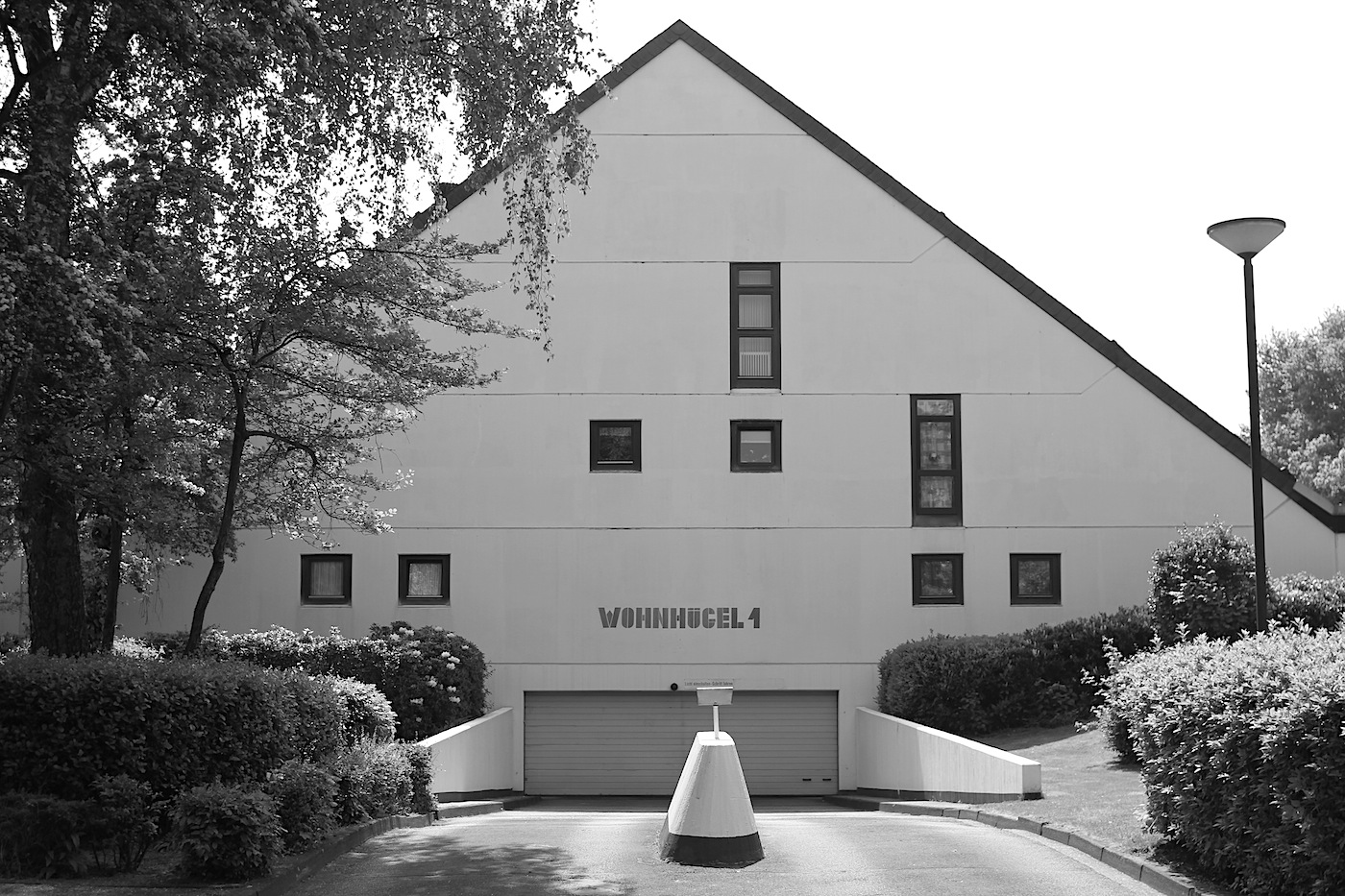
Mountain dwelling 1
In the Kreuzviertel district. For the first time, a type of building was constructed in which the floor area decreases towards the top ...
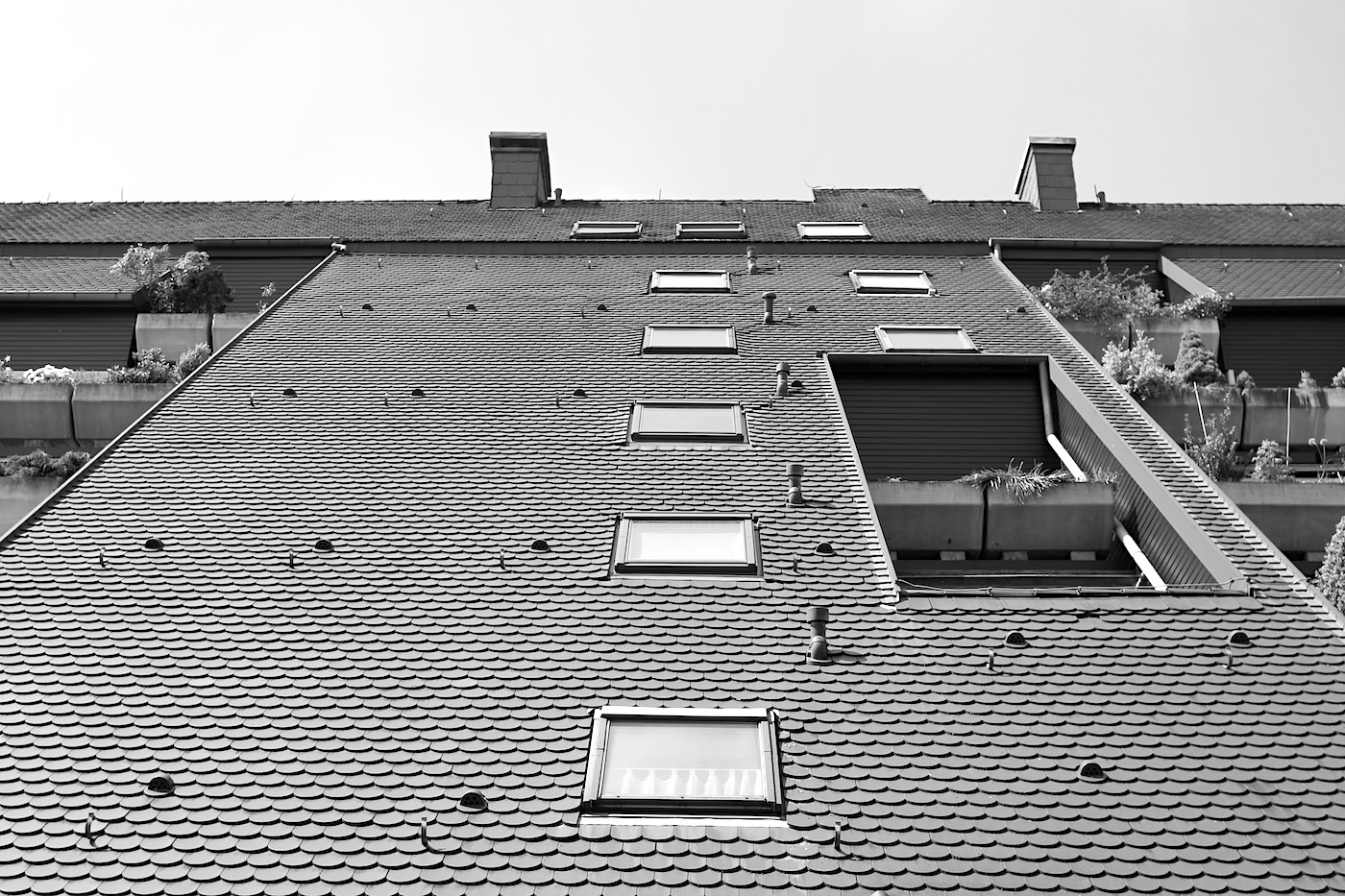
Mountain dwelling 1
… and the storeys are set back.

Mountain dwelling 1
The concept for this type of building was developed by the architects Roland Frey, Hermann Schröder, Klaus Schmidt from Stuttgart and implemented by the Neue Marler Baugesellschaft (NEUMA).
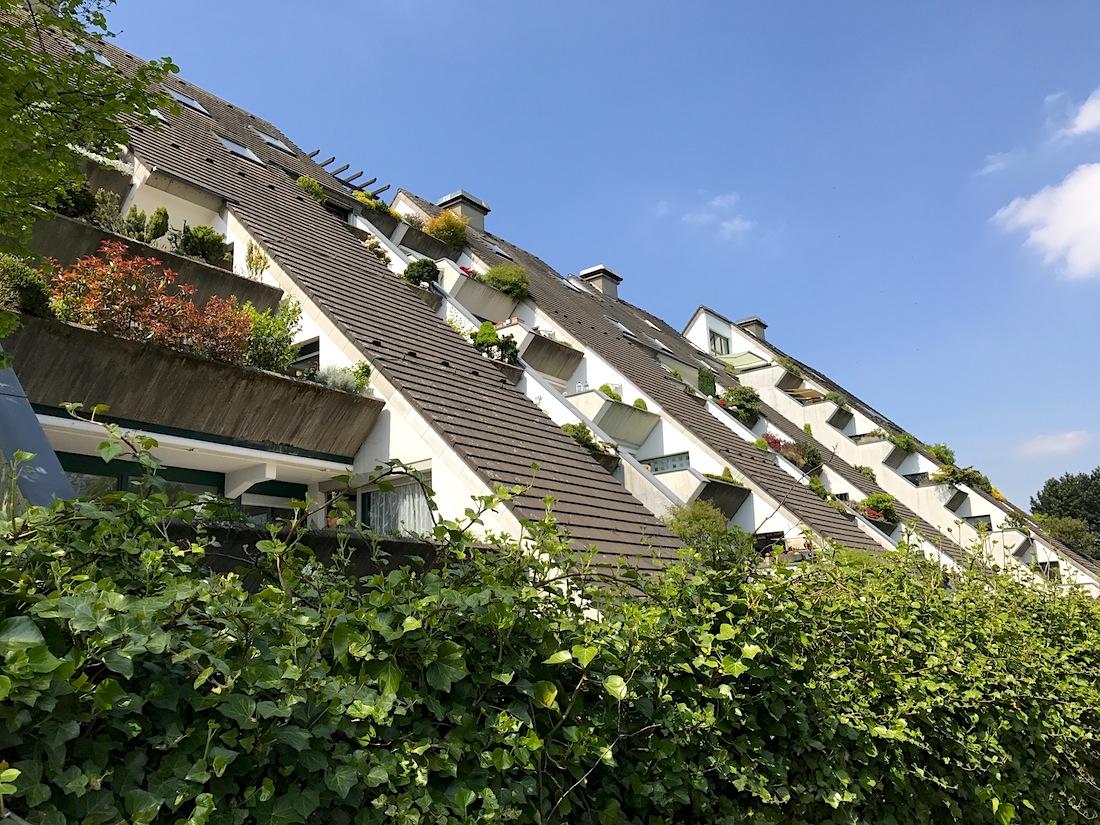
Mountain dwellings
In 1966, a four-storey building was built as a bulk concrete building, featuring a triangular cross-section with four large flats on the ground floor.

Mountain dwellings
The set-back first storey above had also four, but smaller, flats. The second storey had two flats, and the third storey had only one.
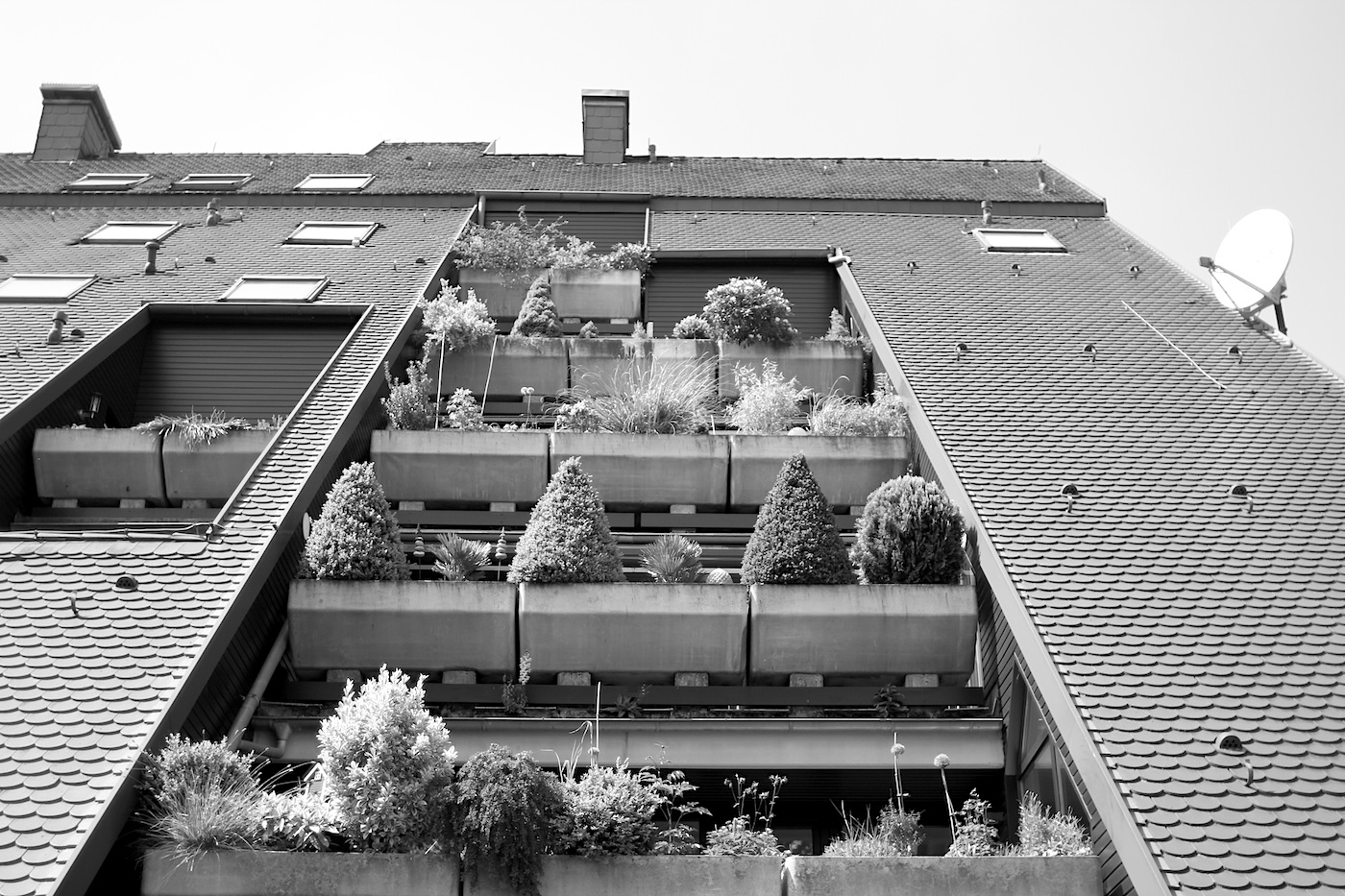
Mountain dwellings
The floor space decreases from storey to storey.

Mountain dwellings
The ground storey has the largest building depth, with nearly 42 meters.

Mountain dwellings
The third storey is just under 10 meters deep.
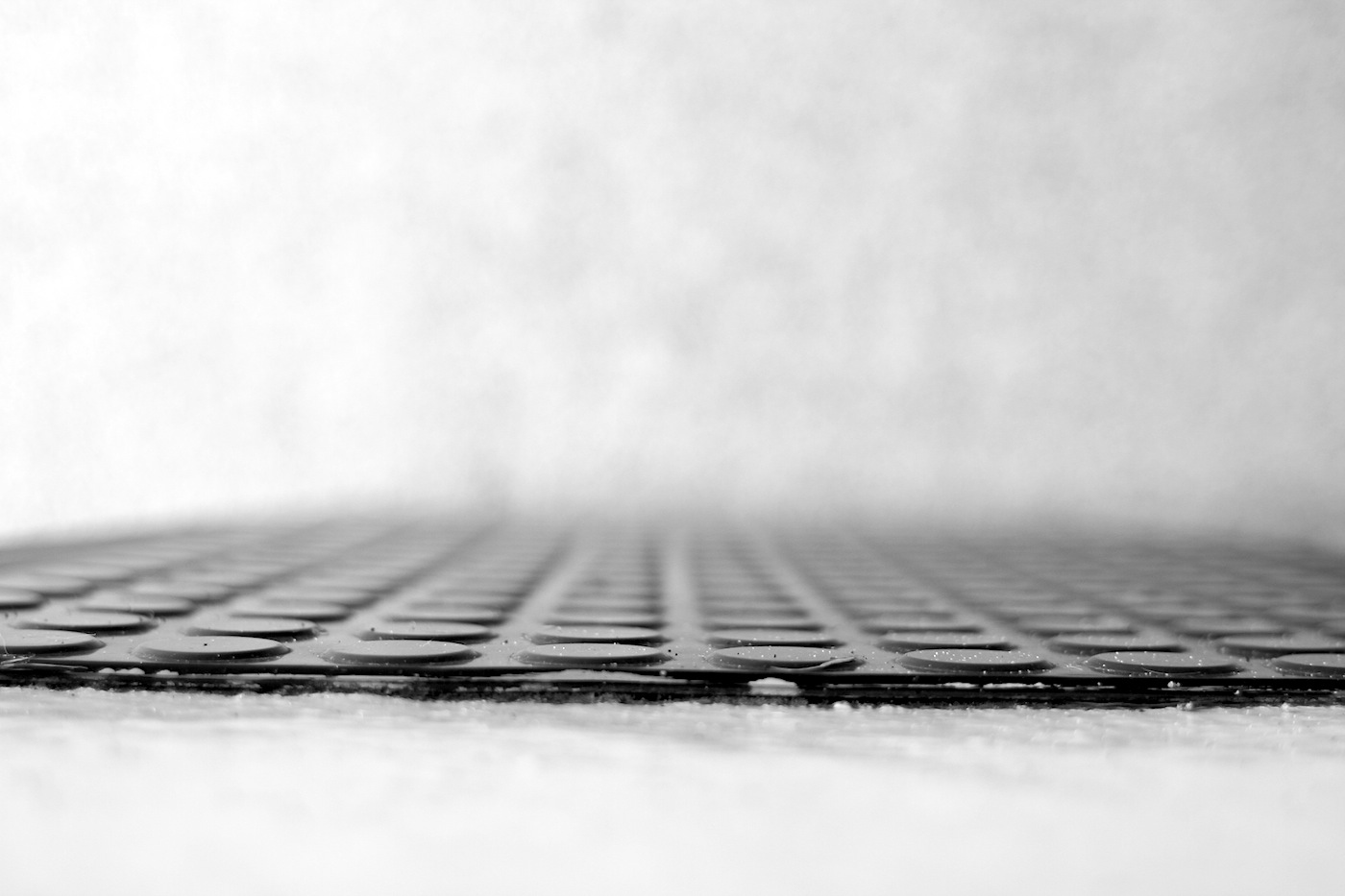
Mountain dwellings
Tidy and lovingly designed down to the detail, for example, with the studded mat in an entrance area.
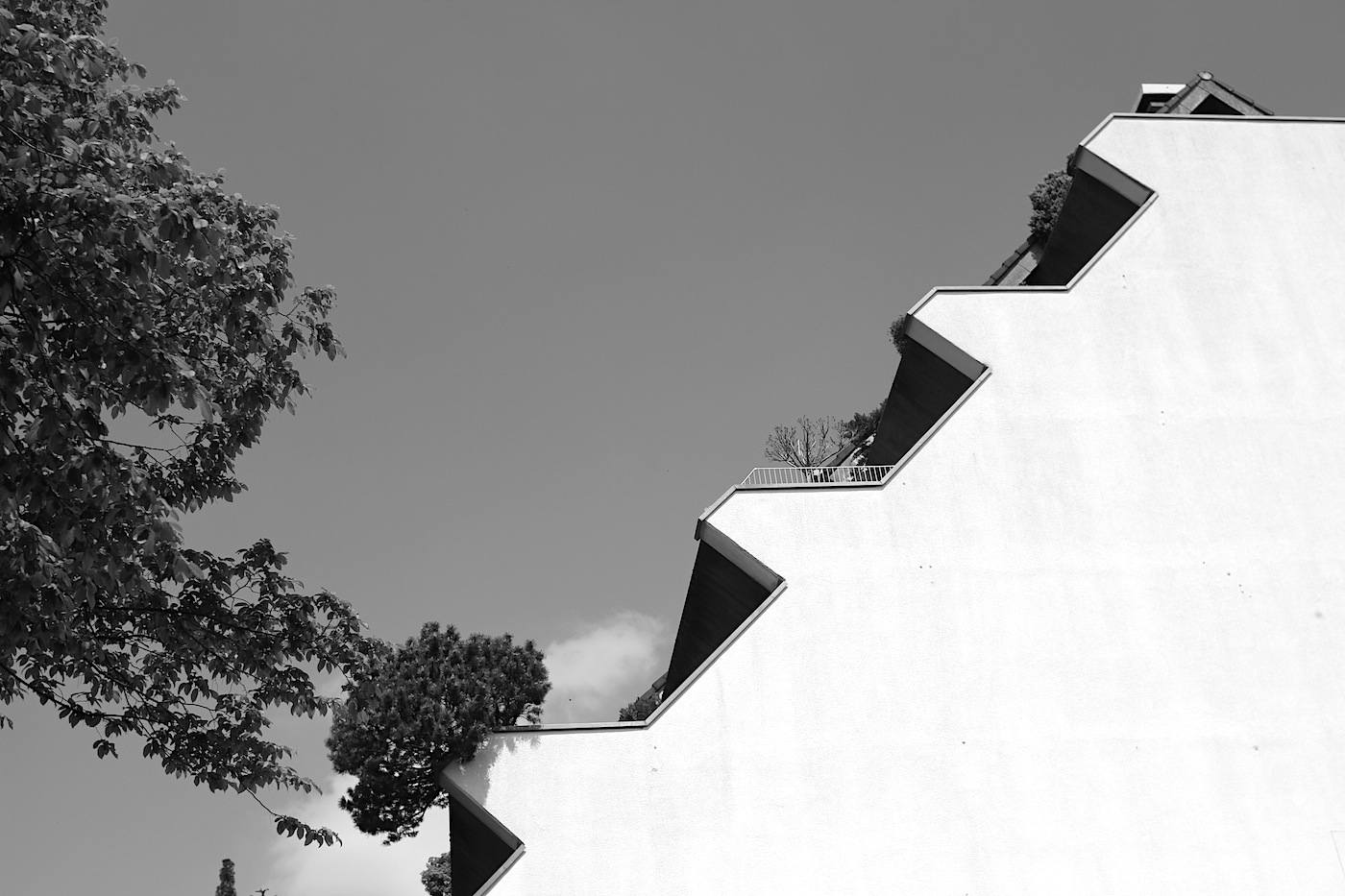
Mountain dwellings
The first mountain dwellings built in the FRG was an unusual and bold development of this residential type. Symbolic for Marl’s architectural utopias.
» ... in this way she made it quite clear that these sculptural treasures belong to us all, and that we as a society are responsible for their preservation. And also that the question about what art we require in our public spaces, and why, must always be answered anew.«
Kay von Keitz, "Skulpturen in Marl", page 61
Of nature machine’s and the Baalbek Gate: Sculptures in Marl
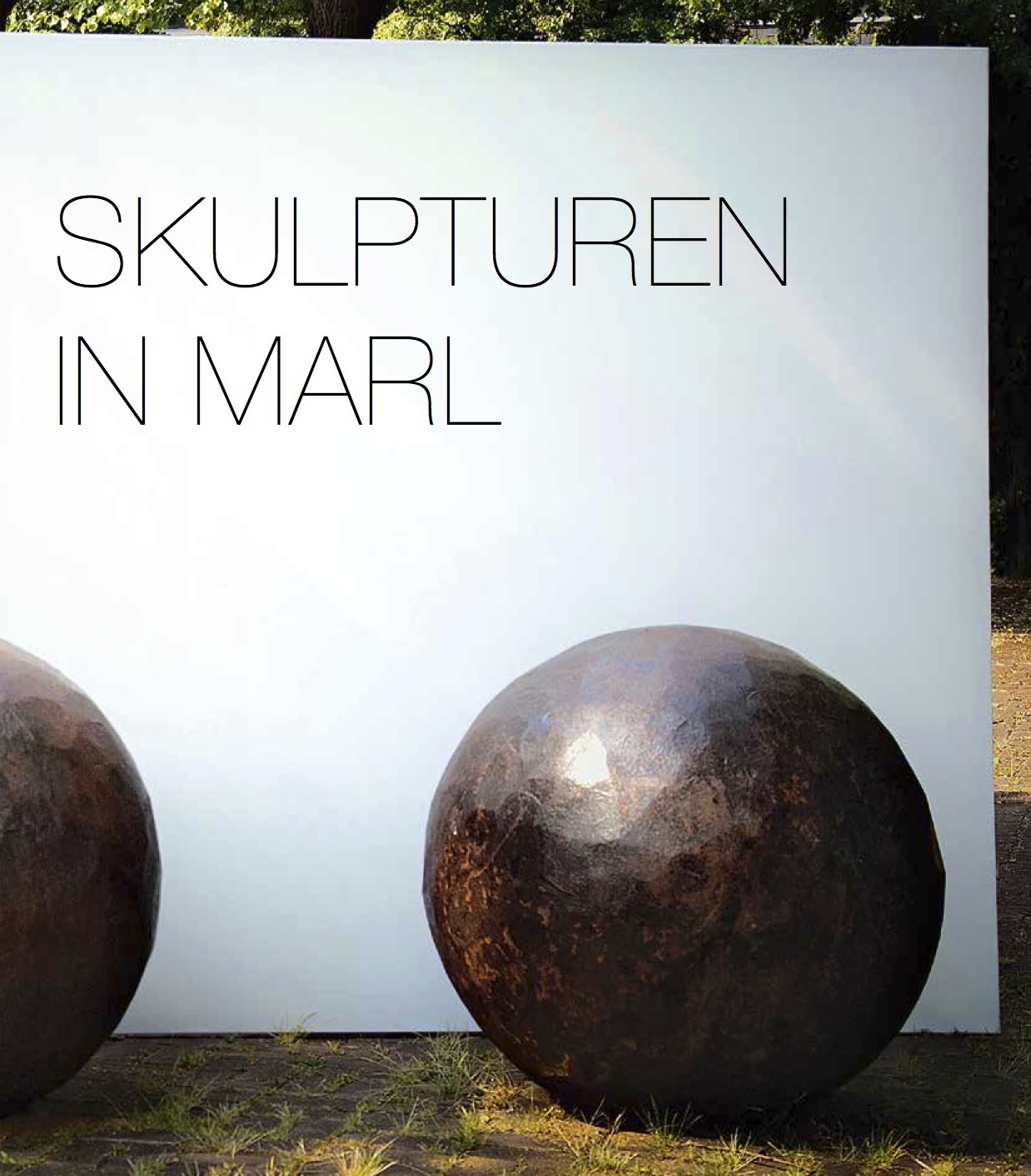
Skulpturen in Marl / Scultpures in Marl
Published by Wienand Verlag Köln
A Forest of Road Signs? The Baalbek Gate? Nature Machine? These works of art by Stefan Wewerka, Carl Bucher and Brigitte and Martin Matschinsky-Denninghoff are part of art city Marl. The city centre is home to such an unusual concentration of high-quality works of art that this immediately apparent to everyone who visits the city. In part they were acquired before the sculpture museum was established in 1982 and before the town hall was built. A whole series of sculptures were bought from the legendary exhibitions Stadt und Skulptur (City and Sculpture) in 1970 and 1972. One of the most popular of the city’s plastics, Brigitte and Martin Matschinsky-Denninghoff’s Naturmaschine from 1969, belongs to this group. In some 60 years many sculptures have been assembled, resulting in the meantime in a collection, which was initially not foreseen. Its high-quality basis owes much to the historically exceptional situation during the economic miracle (Wirtschaftswunder). This was not merely due to the financial possibilities, but also to the qualitative requirements with which the urban planning for a city of 100 000 and more people, with the town hall as “The Crown of the City”, was carried out during the legendary era of Rudolf Heiland as mayor. And of course, art at its highest level belonged to these plans and the avant-garde architecture. The catalogue “Skulpturen in Marl” was published on the occasion of the exhibition Skulptur 2015. The book presents the 80 and more sculptures with descriptions, essays (both in German and English language) and photos – a catalogue for those, who want to discover Marl’s city centre and architecture through its art, sculptures and installations.
»We should therefore set for ourselves simple and clear goals, namely to serve the living culture by planning and implementing types of living spaces that are as varied as possible.«
Dr. Günther Marschall, urban planner and architect, who planned a number of buildings in Marl
Going #urbanana
Discover the urban jungle of western Germany. A little-known, unconventional but well-formed metropolis of 10 million stretches from the Rhineland to the Ruhr Area. Multi-faceted, eccentric, creative: #urbanana is forming an banana-shaped republic with hazy boundaries. Raw concrete and daisy chains, city activists and locals brimming with ideas, great festivals and small galleries, incompleteness and abundant good taste — #urbanana celebrates undiscovered spaces for expeditions free of hype. #urbanana is the forerunner of the renaissance of the western Germany. We home in on curiosity and zoom from Cologne, Düsseldorf and the Ruhr beyond the neighbours and into the streets and backyards until we, urban wanders, are knocking courageously at the doors of the movers and shakers, collectors and hunters, sisters in spirit and perhaps even friends.
Town hall of Marl
Address: Creiler Platz 1, 45768 Marl. Designed by the architects Johan Hendrik van den Broek and Jacob Berend Bakema from Rotterdam, Netherlands.
Sculpture Museum / Skulpturenmuseum Glaskasten
Address: Creiler Platz, next to the town hall, 45768 Marl, email: skulpturenmuseum@marl.de, Tel.: +49 2365 99 22 57. Opening hours: Tue.–Fri. 11 a.m.–5 p.m., Sat. and Sun. from 11 a.m.–6 p.m.
Grimme Institute
Address: Eduard-Weitsch-Weg 25, 45768 Marl. Tel.: +49 2365 9189-0, email: info@grimme-institut.de. The former adult education centre was designed by Günter Marschall and completed in 1955. In 2015 it was renovated by Prof. Spital-Frenking and Schwarz Architekten.
Marler Stern
Address: Bergstraße 228, 45768 Marl. Opening hours: Mon.–Fri.: 9:30 a.m.–7 p.m., Sat.: 9:30 a.m.–6 p.m. Designed by architects Riedel and Ludmann, completed in 1974. The shopping centre has the largest airbag roof in Europe.
Scharoun school
Address: Westfalenstr. 68a, 45770 Marl. Designed by Hans Scharoun (1893–1972), completed in 1970. Renovated for 10,5 million euro and reopened in 2015 for 2 schools.
Mountain dwellings
Address: Kreuzstraße 321, 45770 Marl. First building completed in 1968, other mountain dwellings in the 1970s and 1982. “Wohnhügel 1” was designed by architects Roland Frey, Herman Schröder, Peter Faller and Claus Schmidt.
Brasília
is the federal capital of Brazil and seat of government of the Federal District. The city is located atop the Brazilian highlands in the country's center-western region. It was founded on April 21, 1960, to serve as the new national capital. Brasília was planned and developed by Lúcio Costa and Oscar Niemeyer in 1956 to move the capital from Rio de Janeiro to a more central location. The landscape architect was Roberto Burle Marx. The city's design divides it into numbered blocks as well as sectors for specified activities, such as the Hotel Sector, the Banking Sector and the Embassy Sector. Brasília was chosen as a UNESCO World Heritage Site in 1987 due to its modernist architecture and uniquely artistic urban planning.
Scultpures in Marl
By Wienand Verlag Köln. In German and English language. 238 pages, 226 photos, 21 x 24 cm. ISBN 978-3-86832-322-1